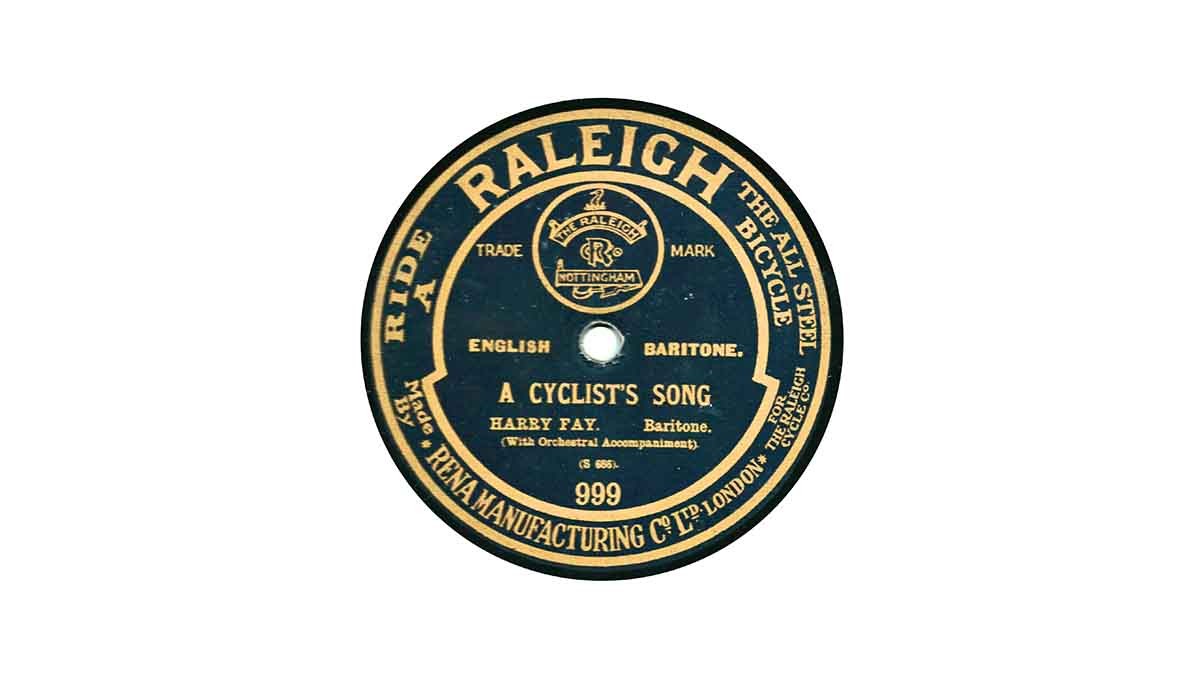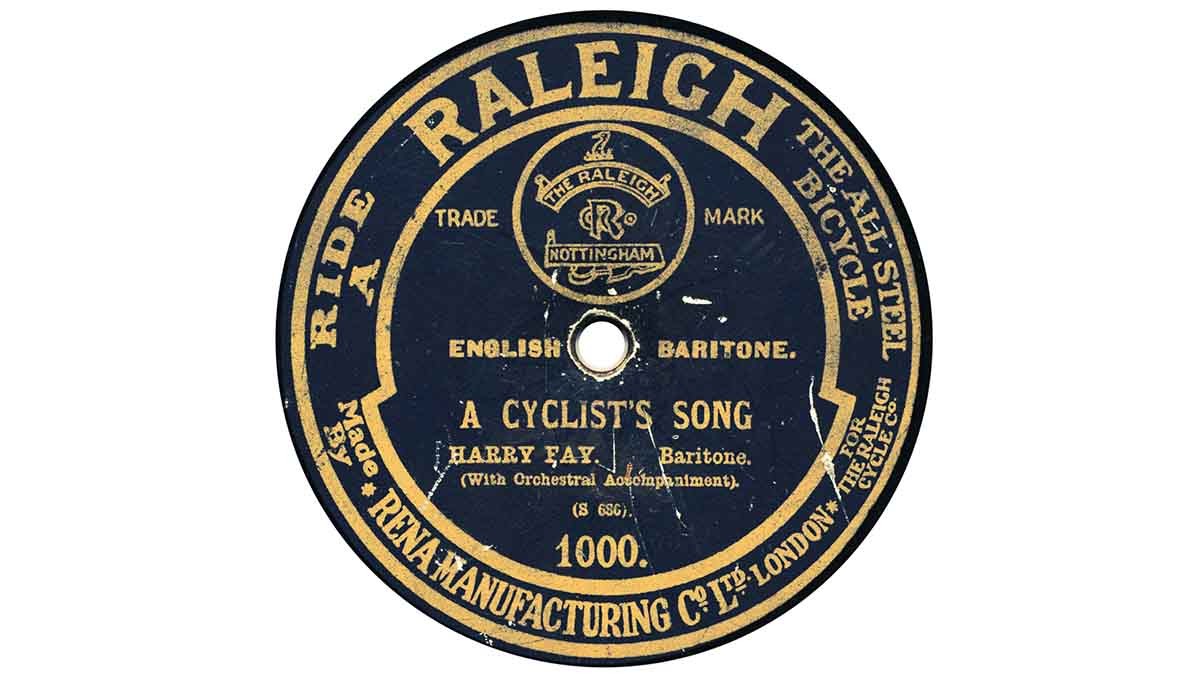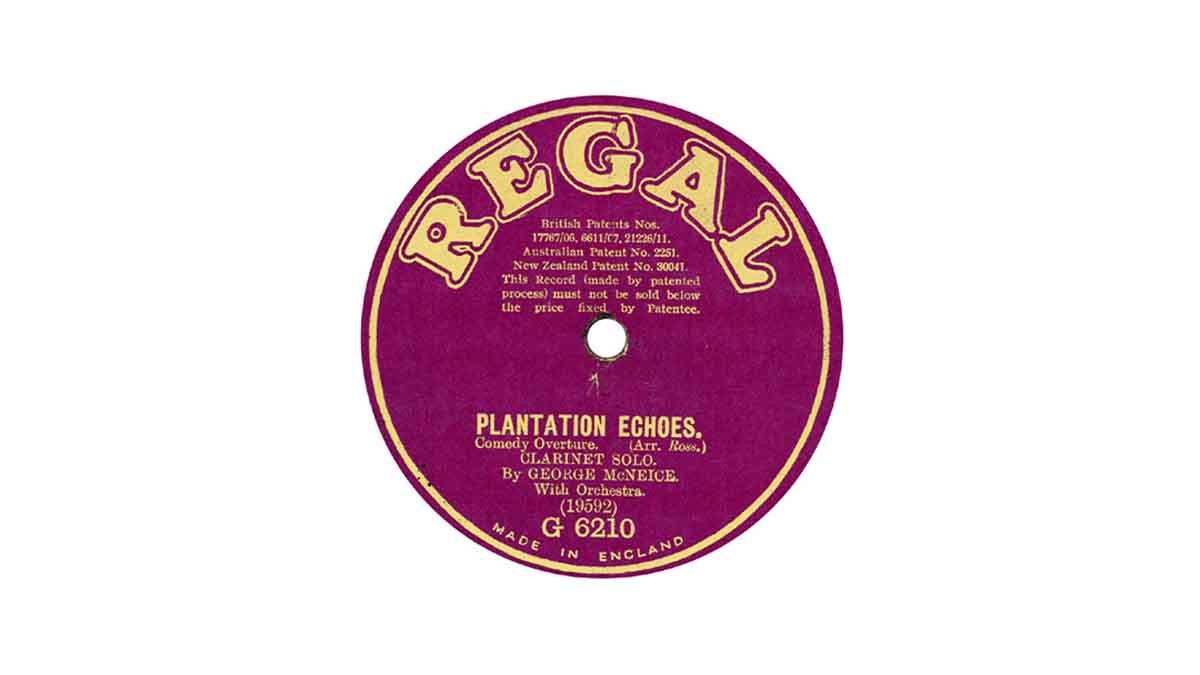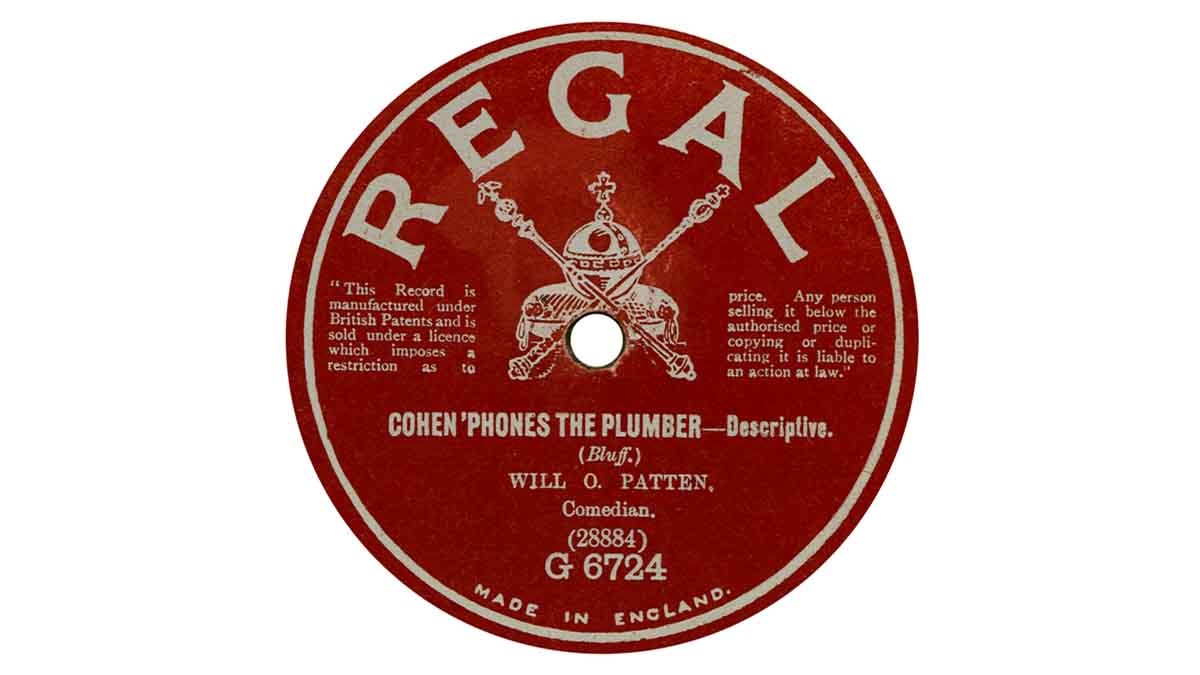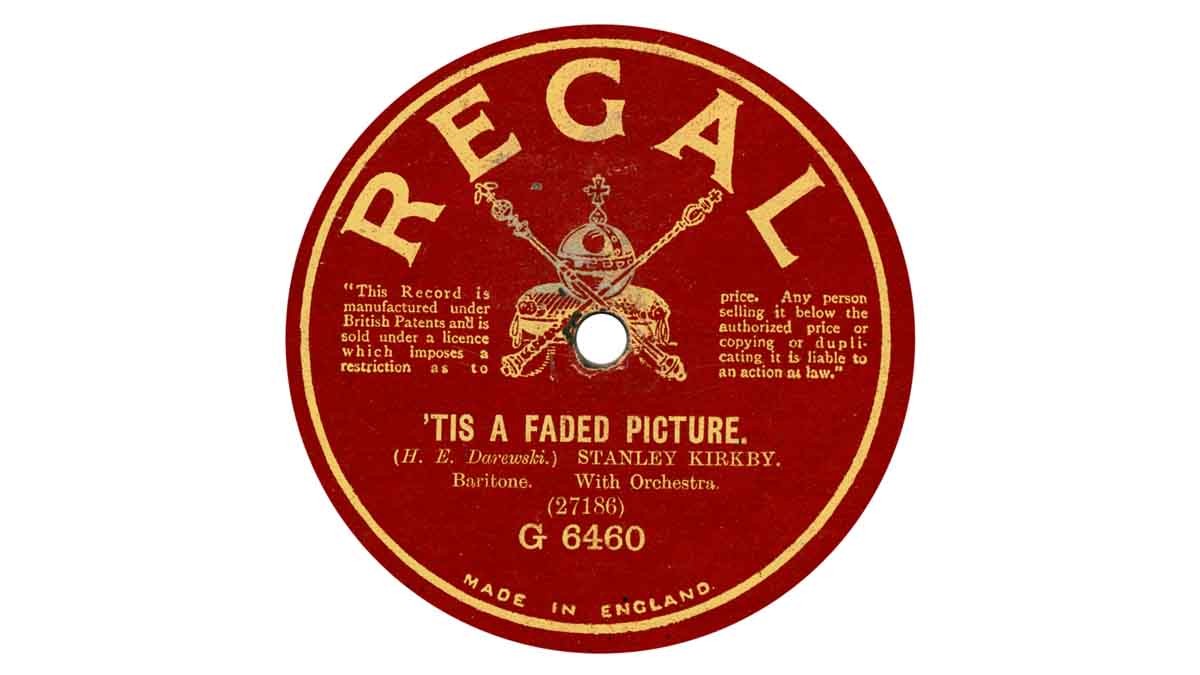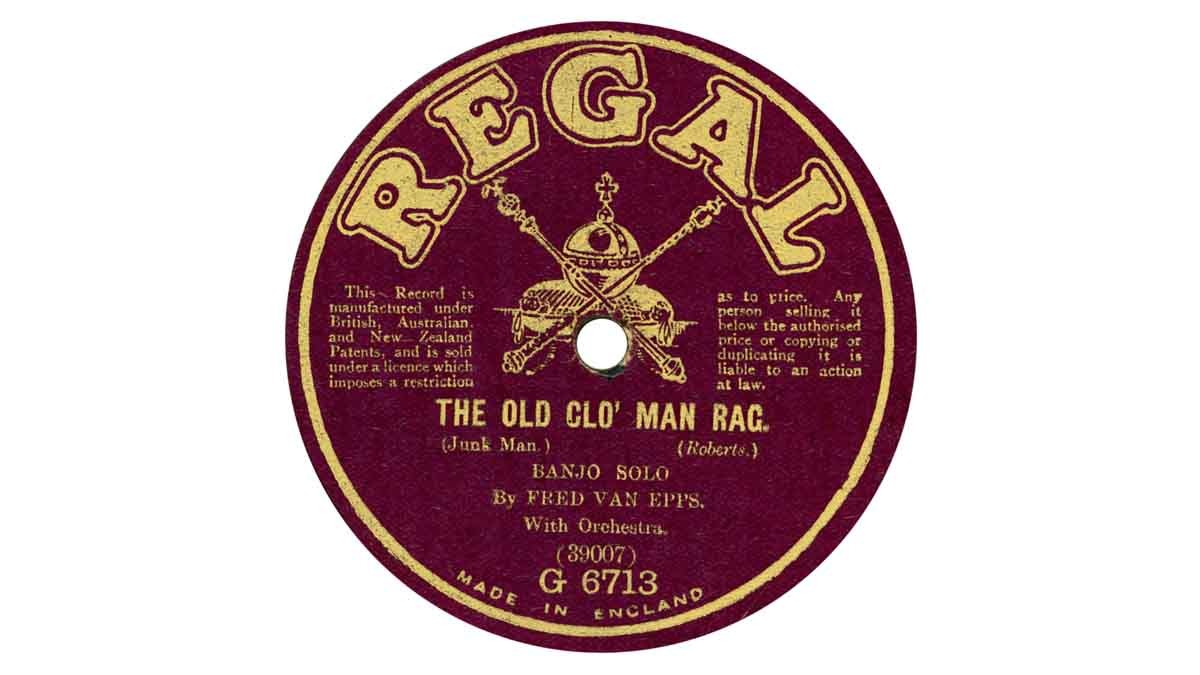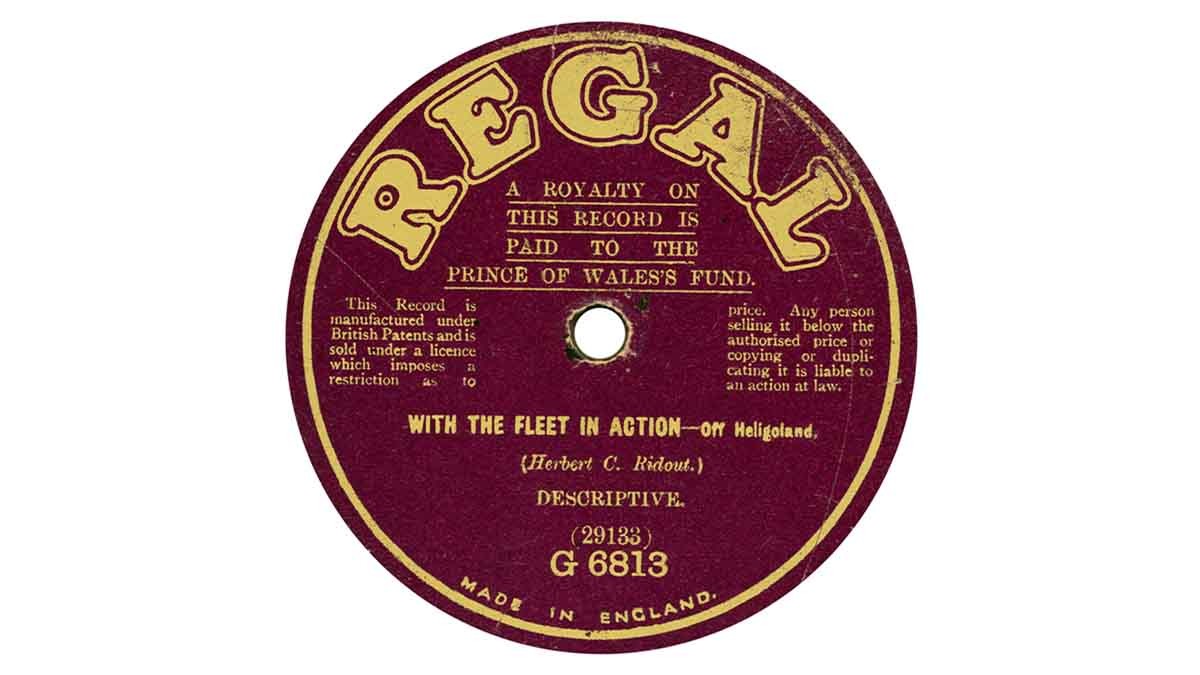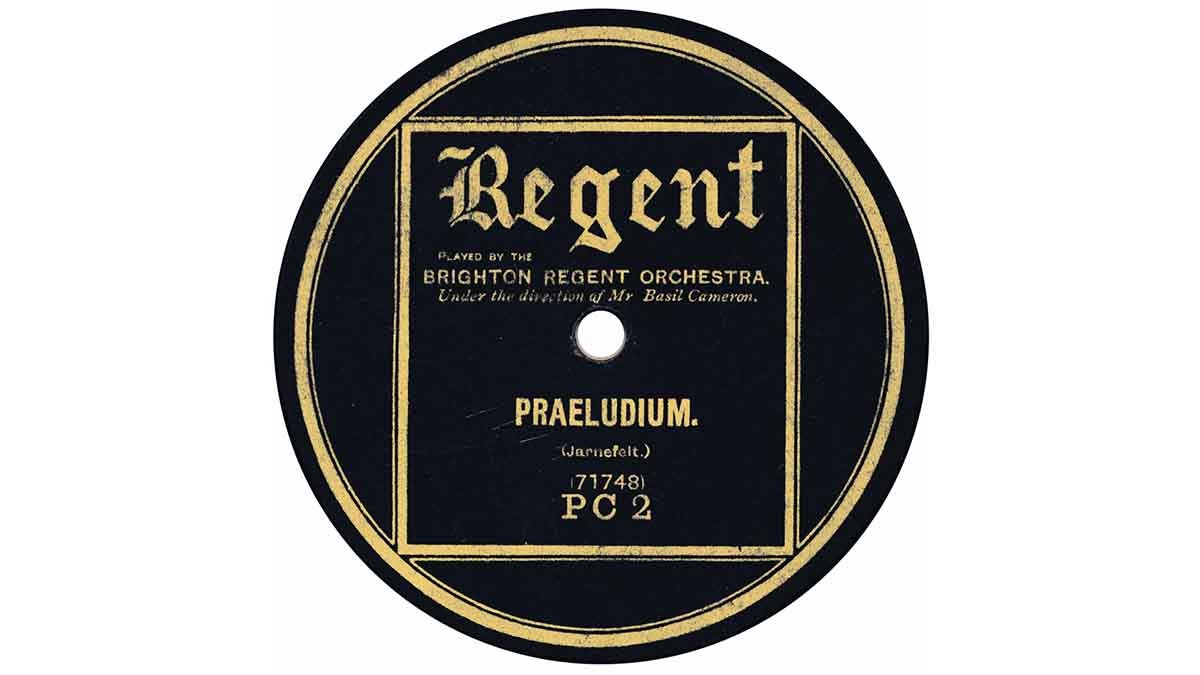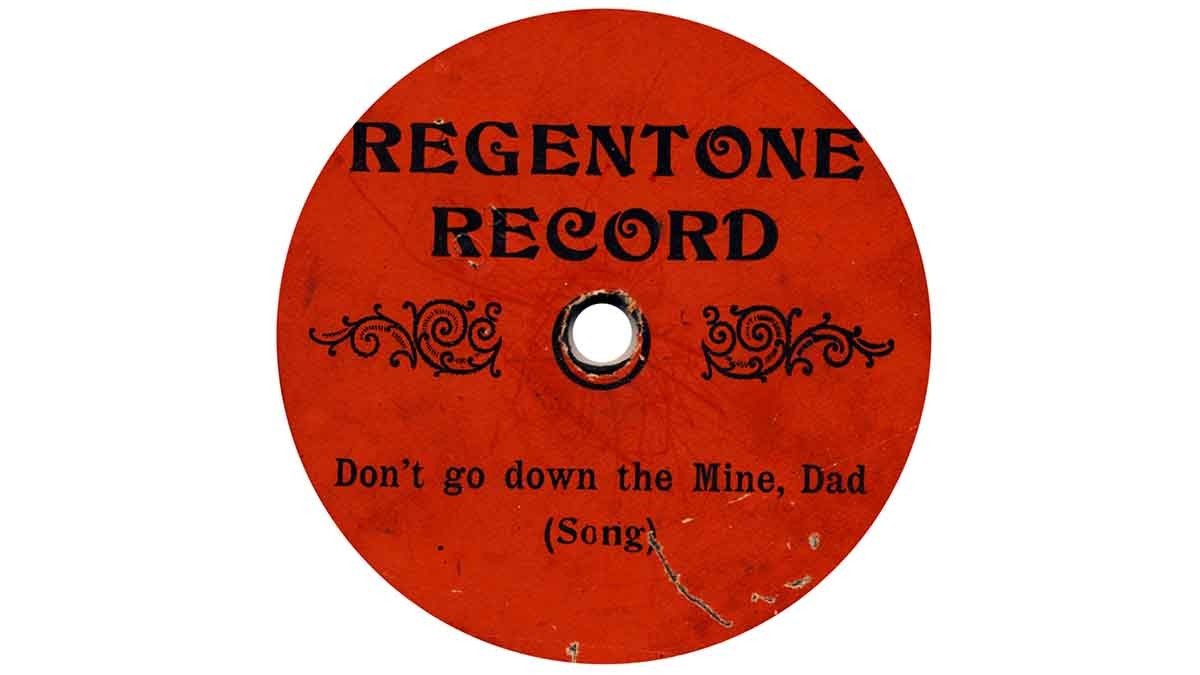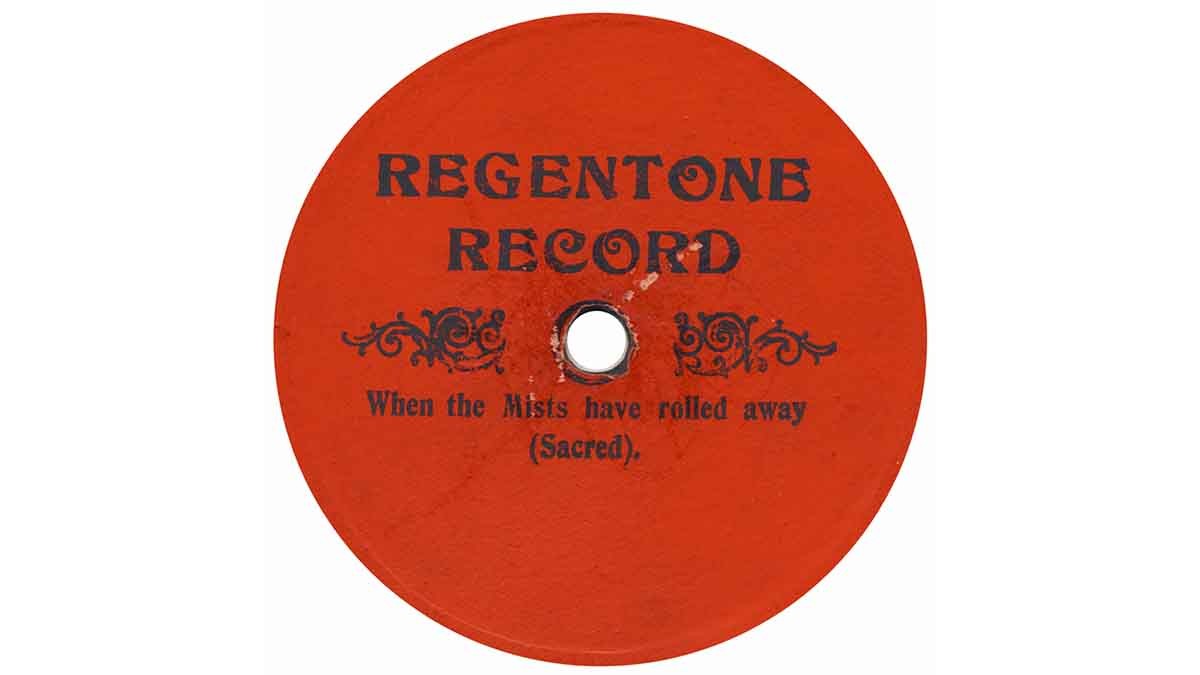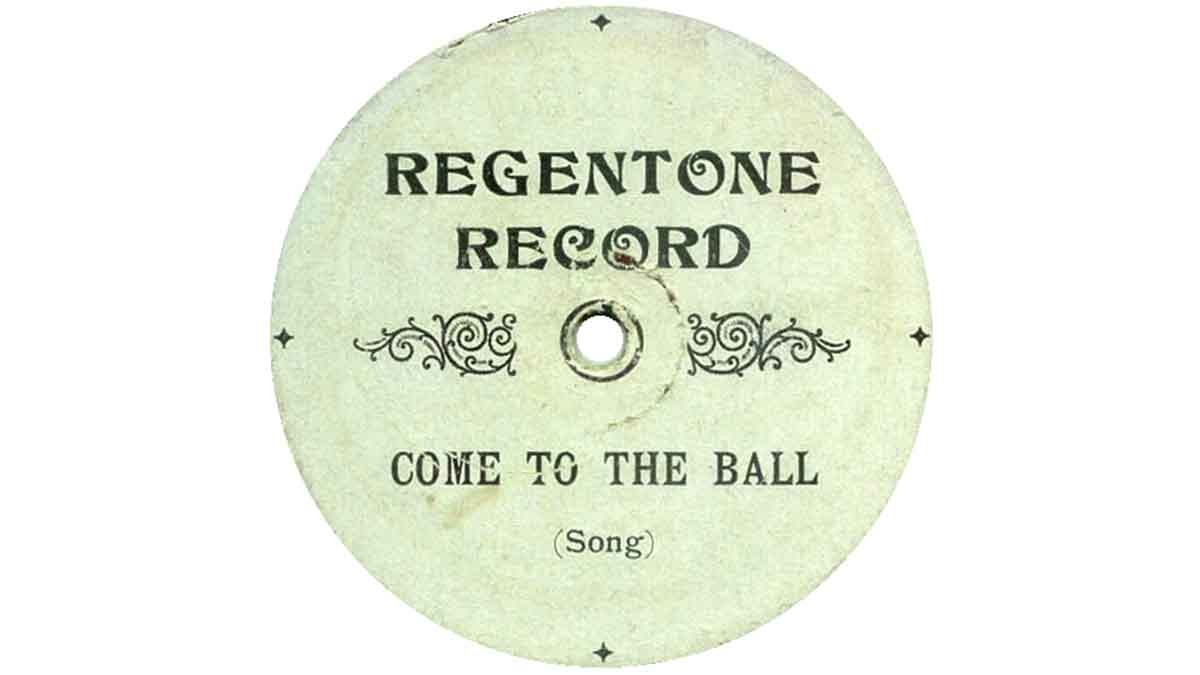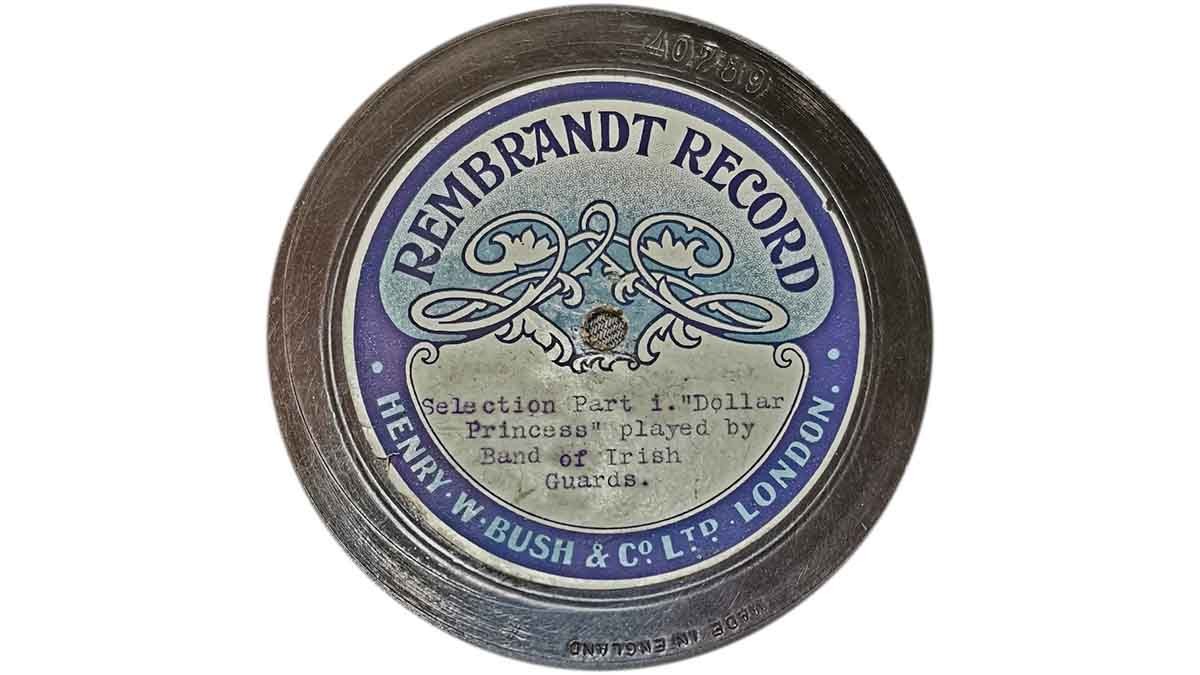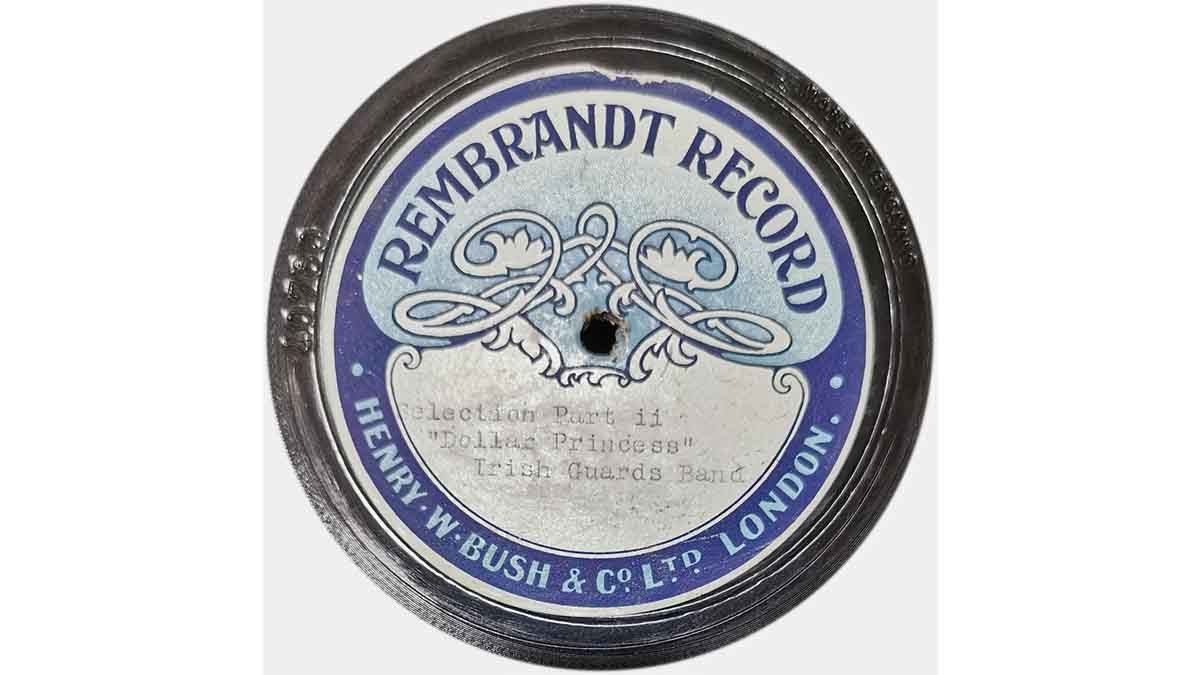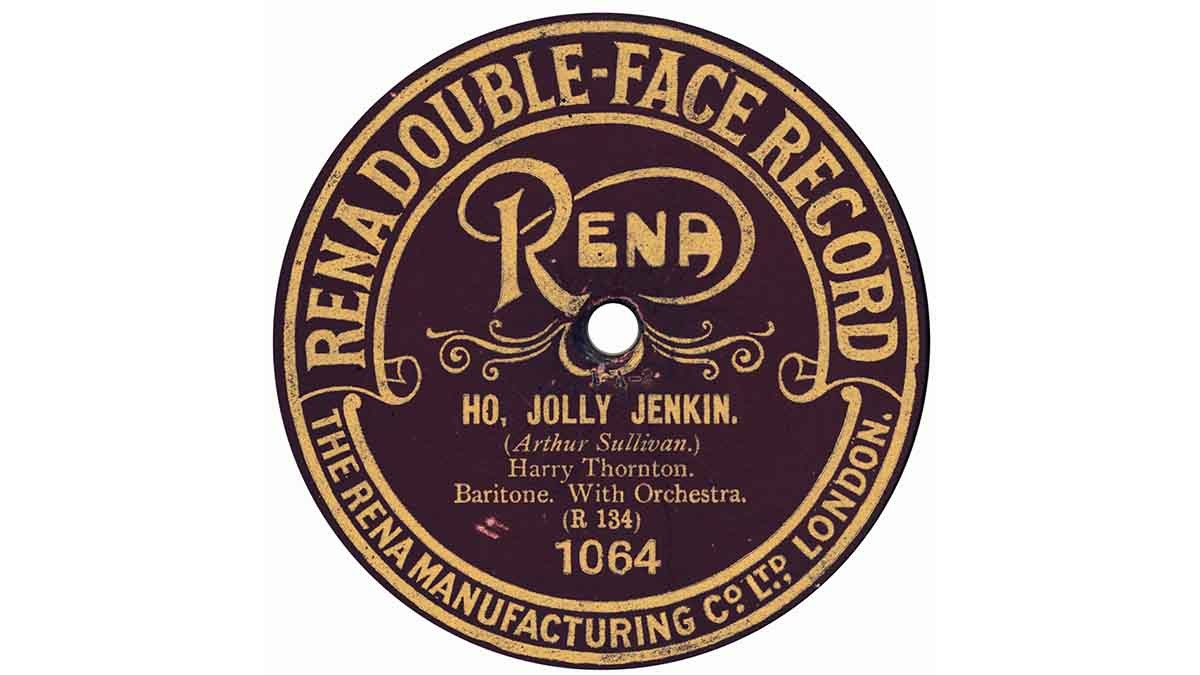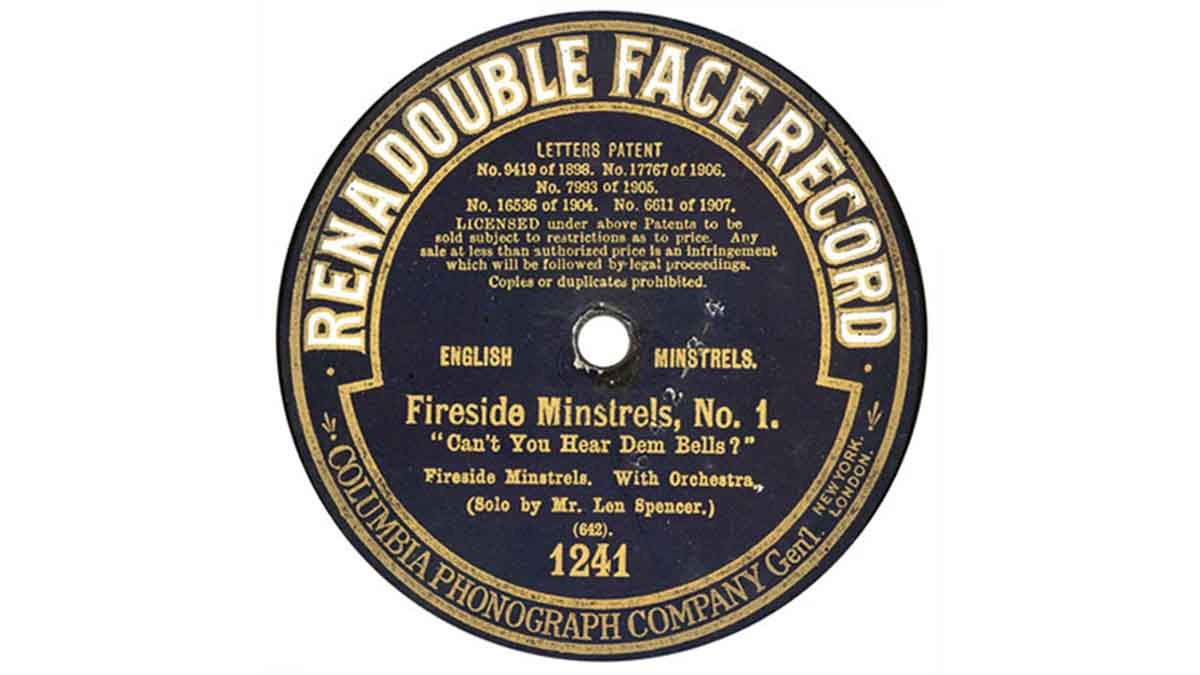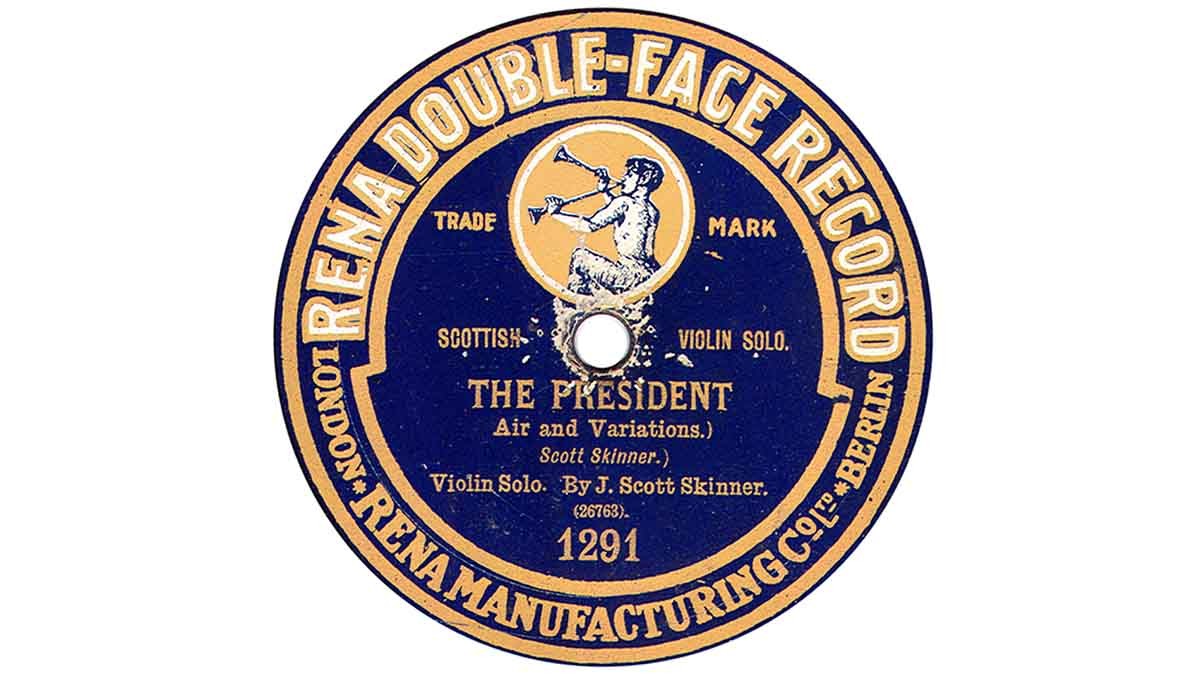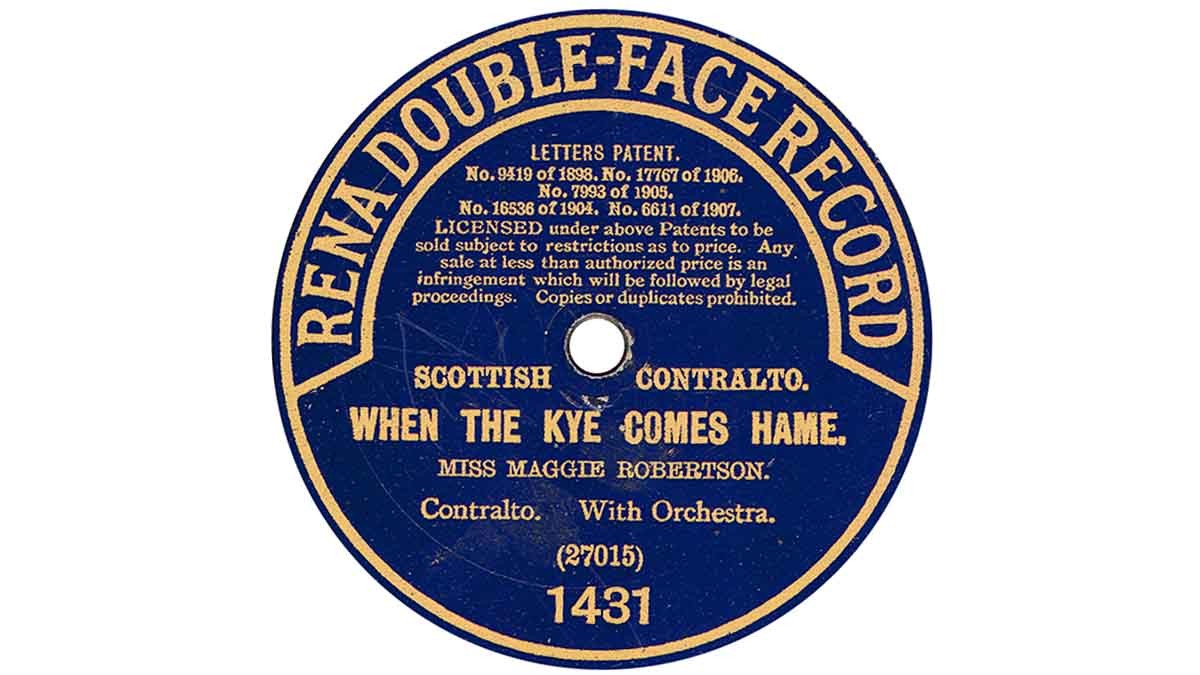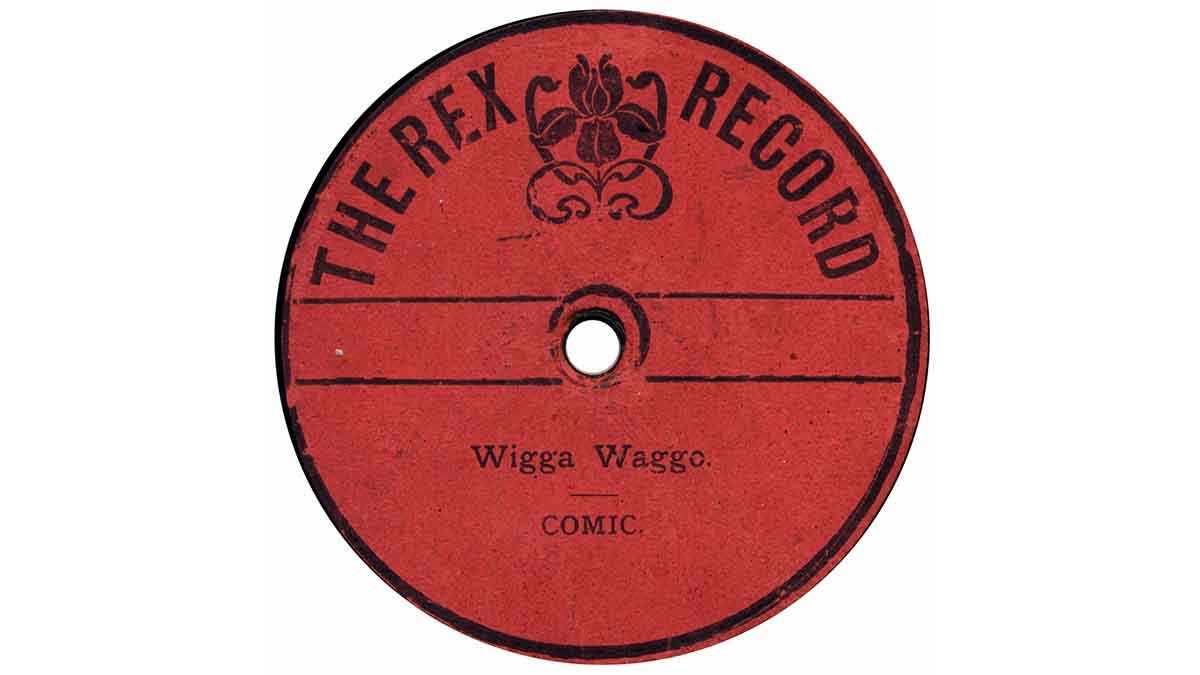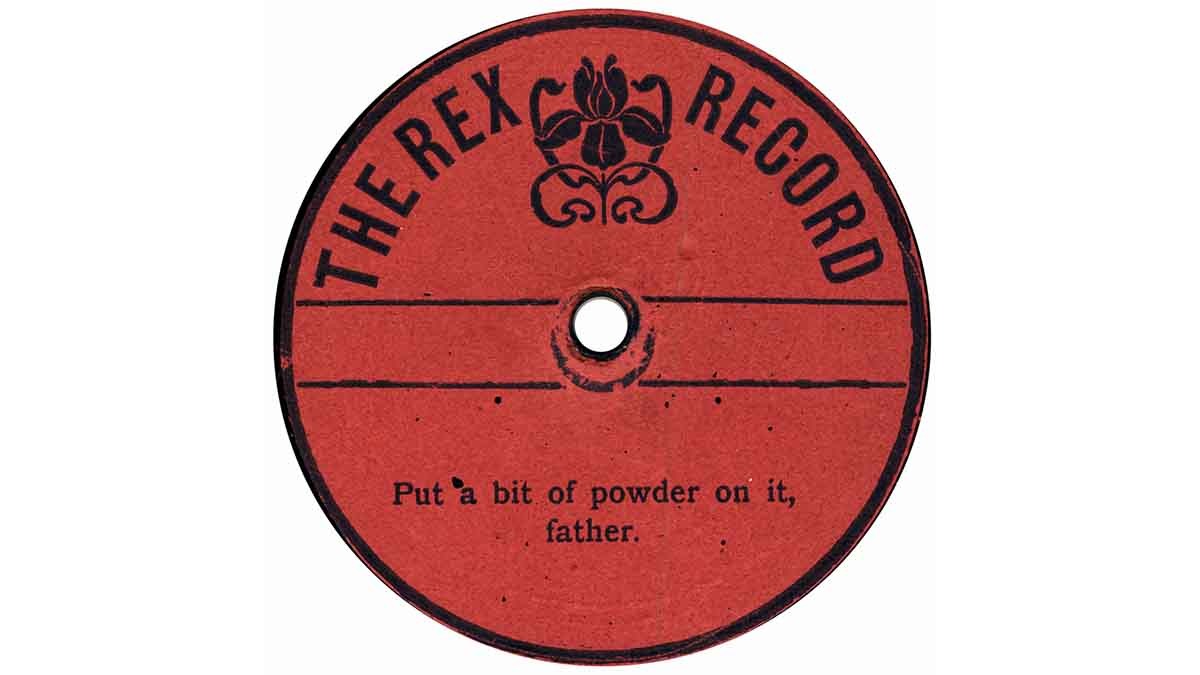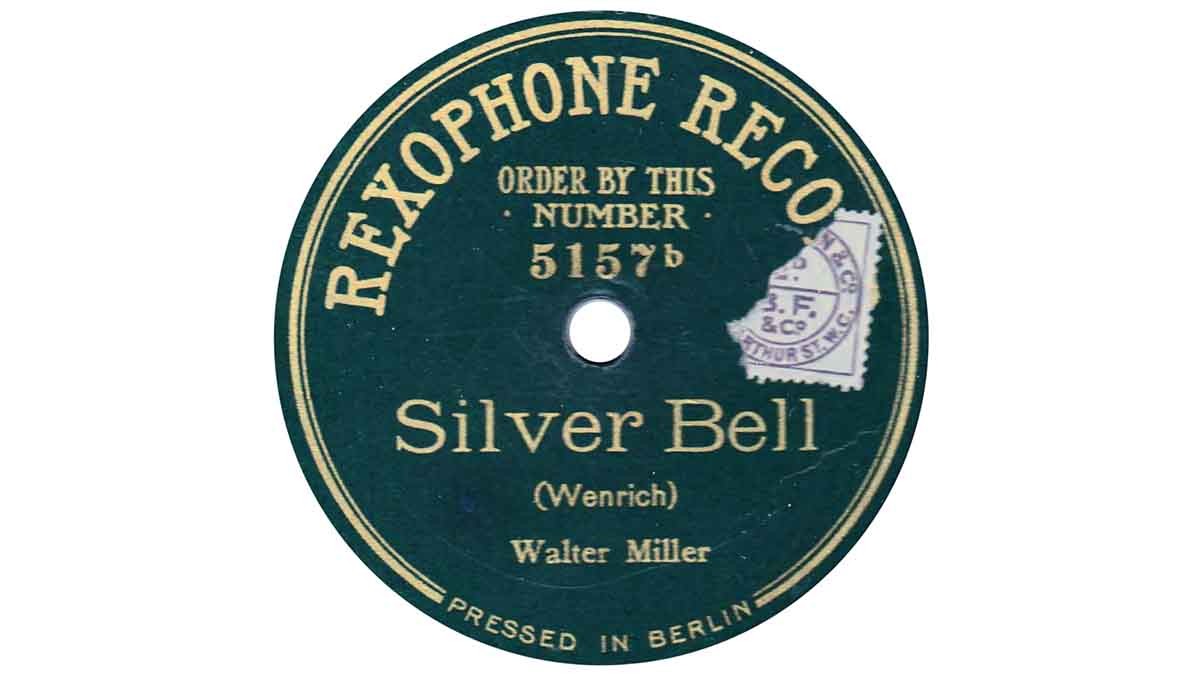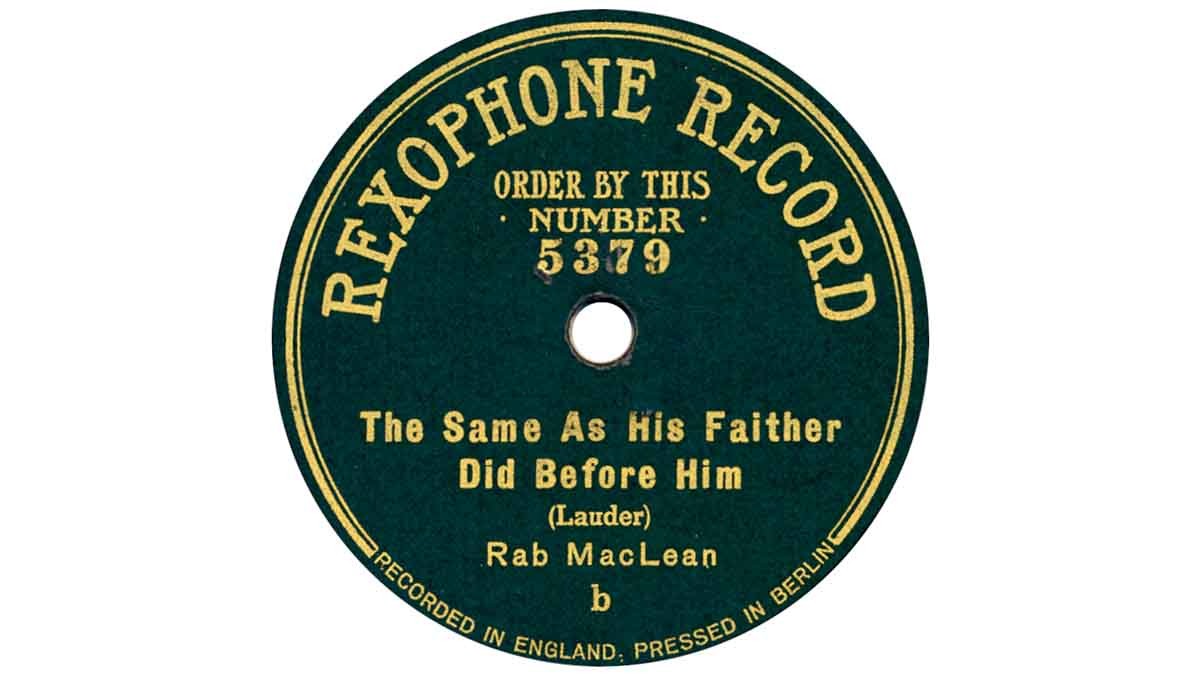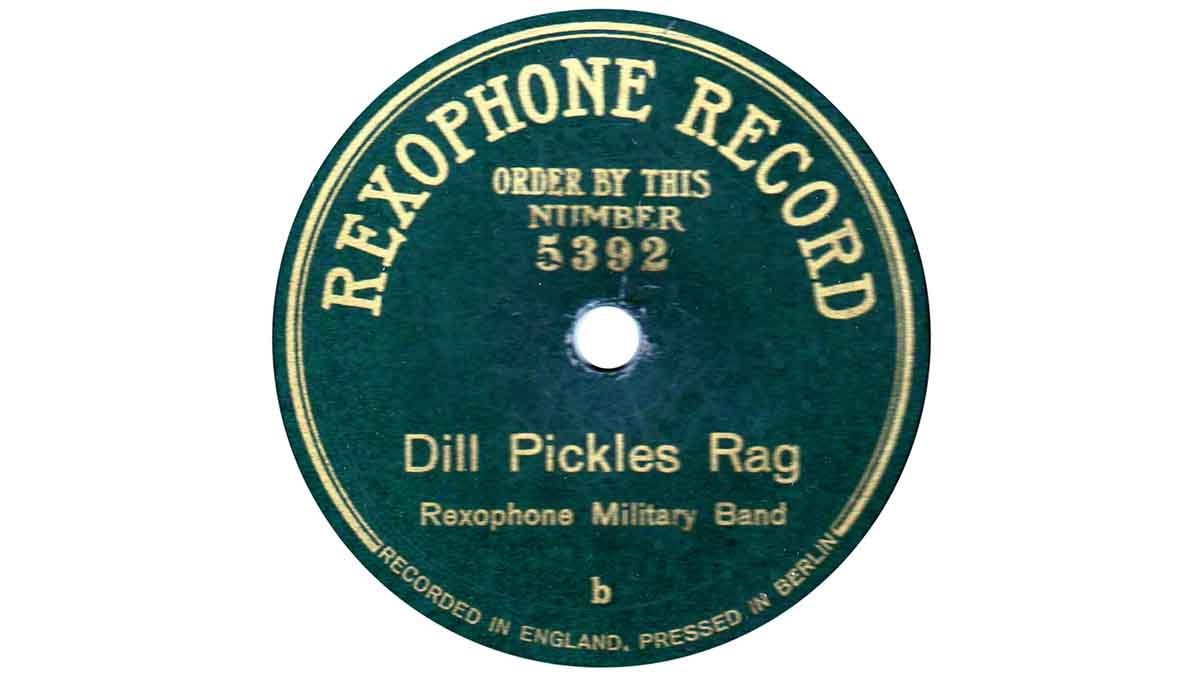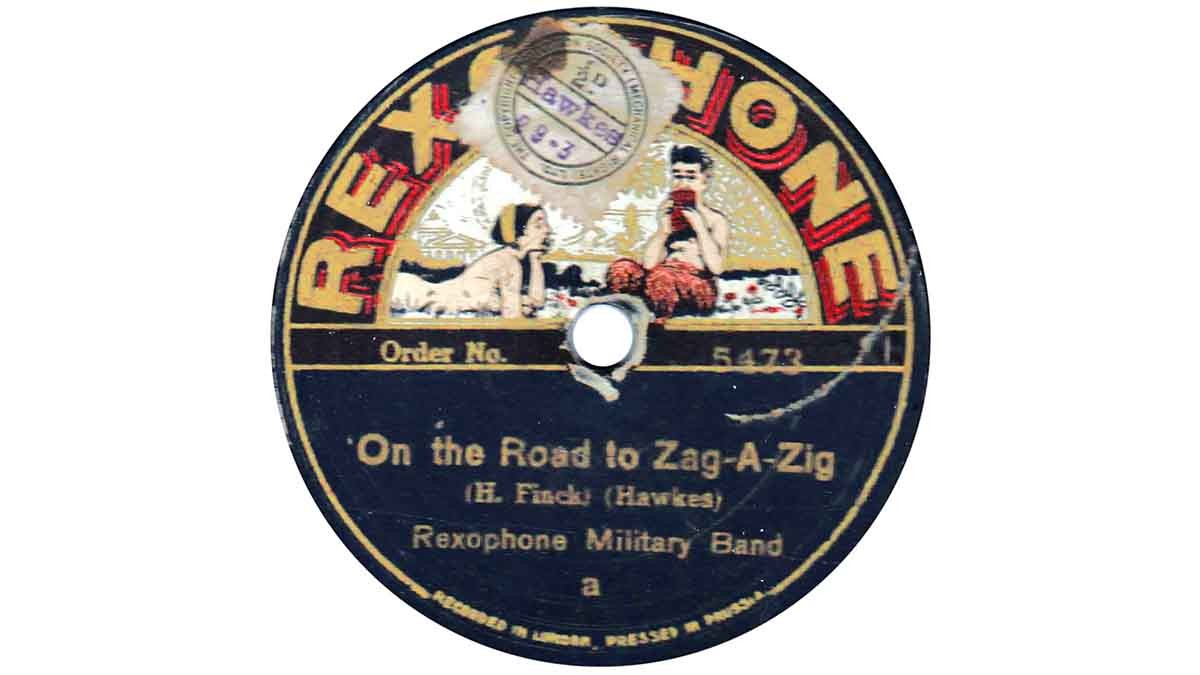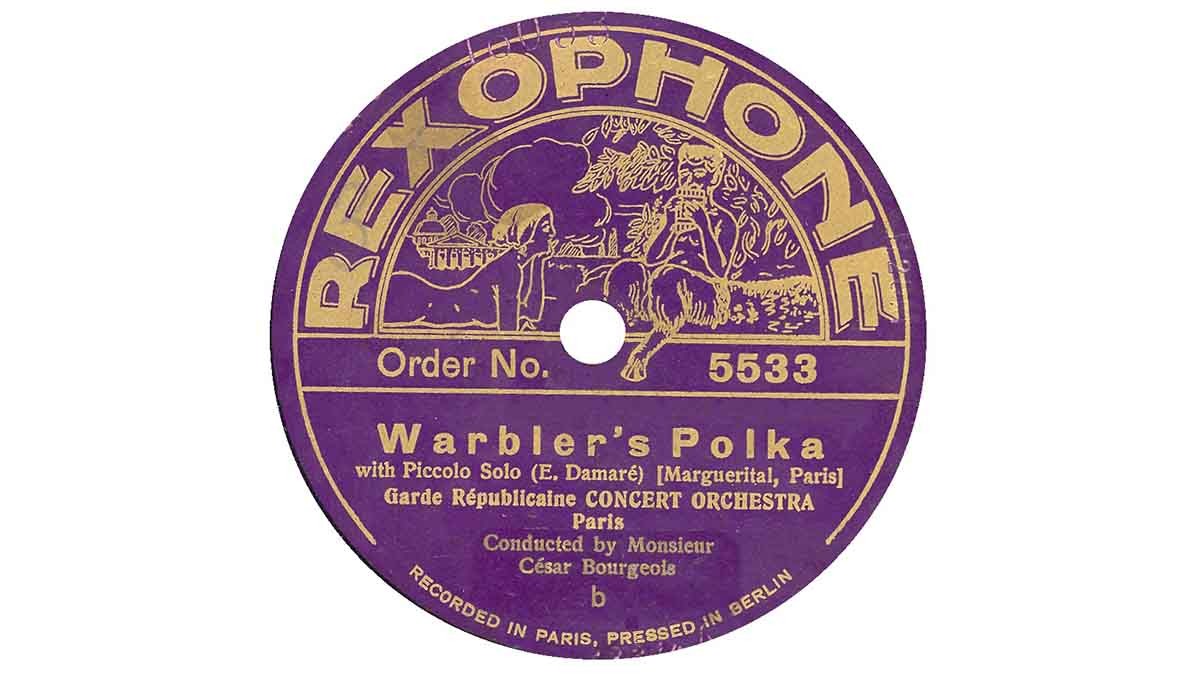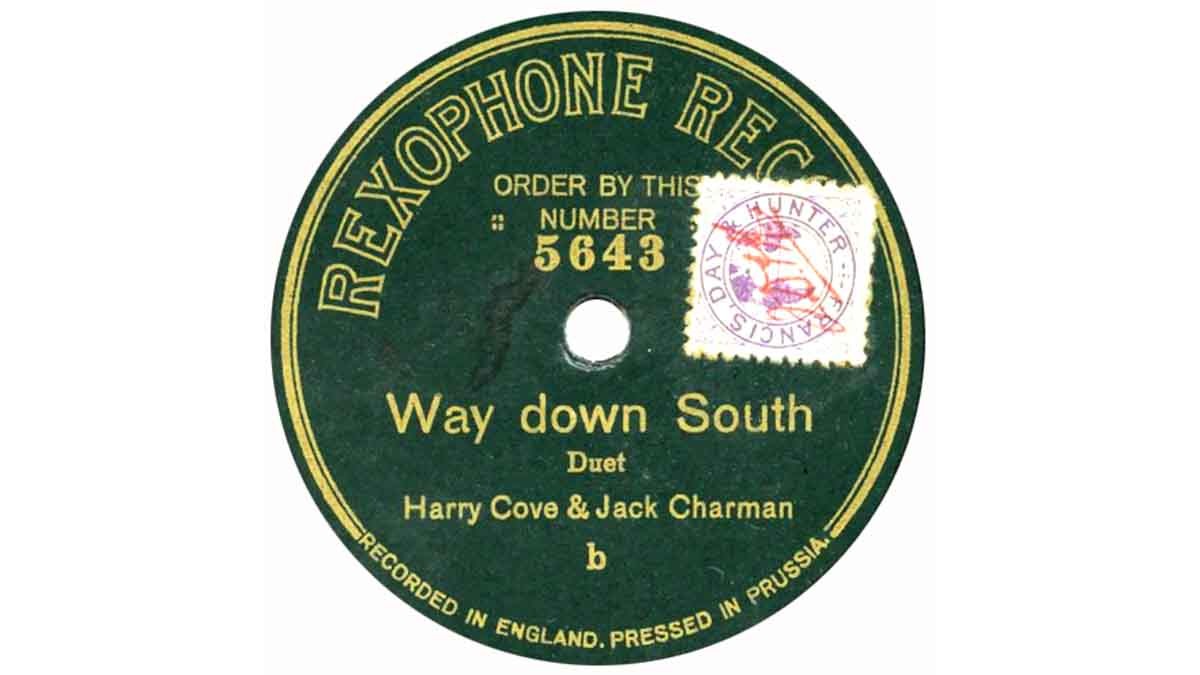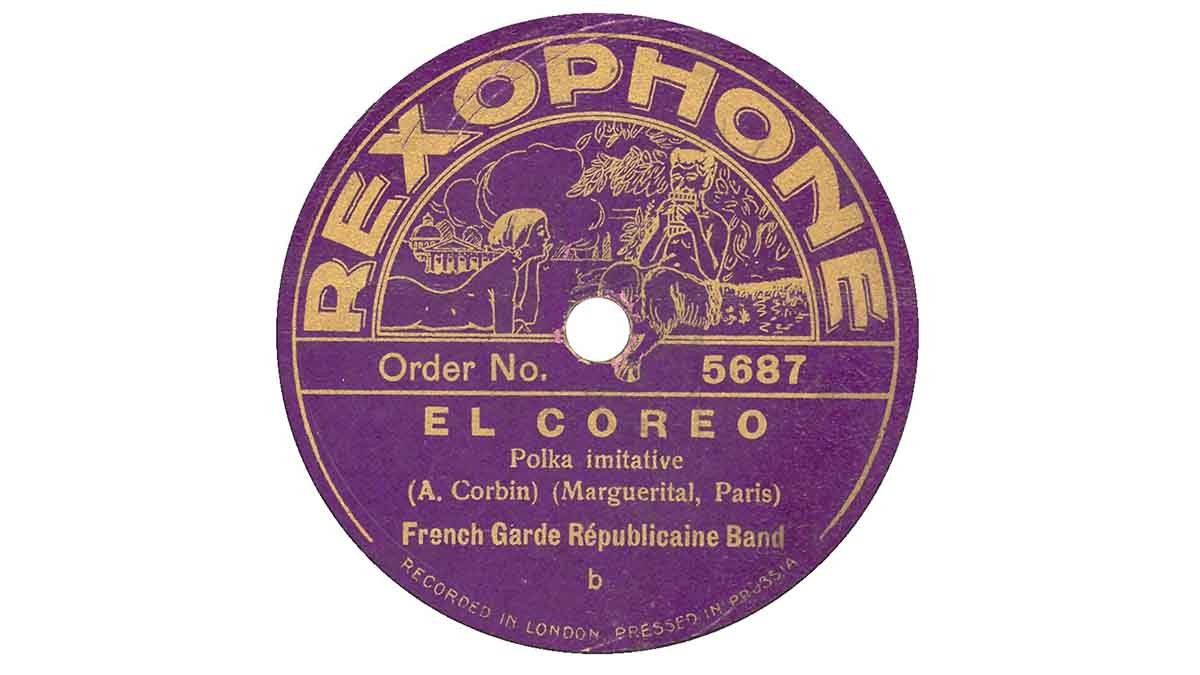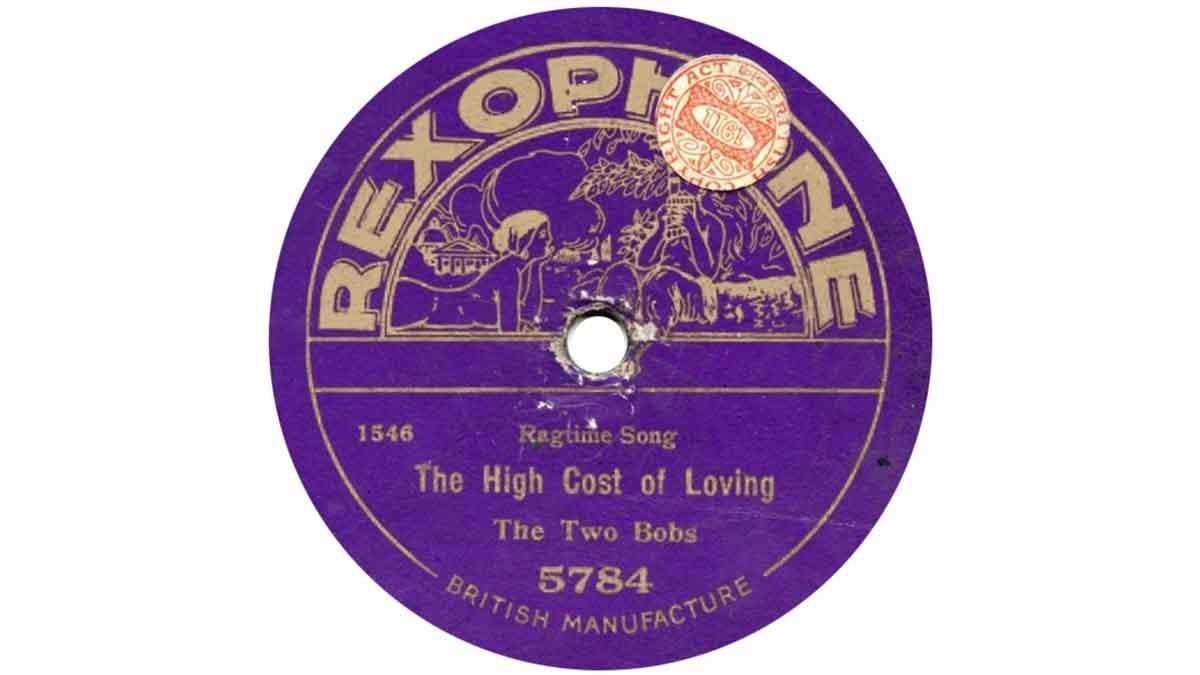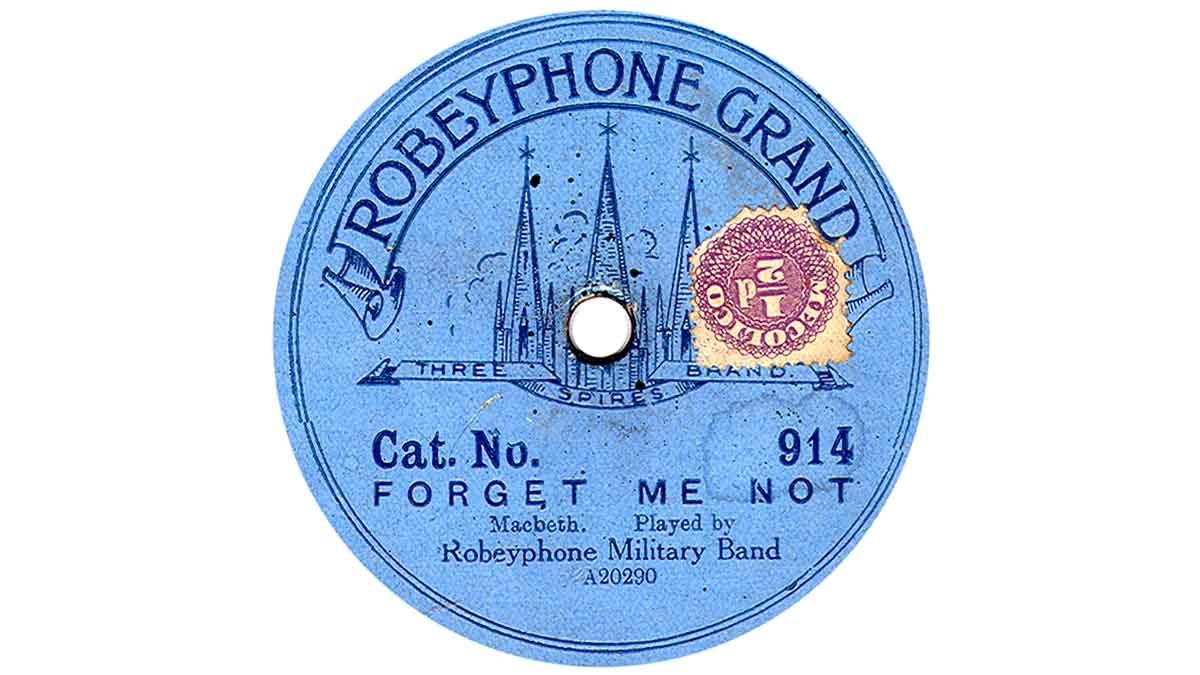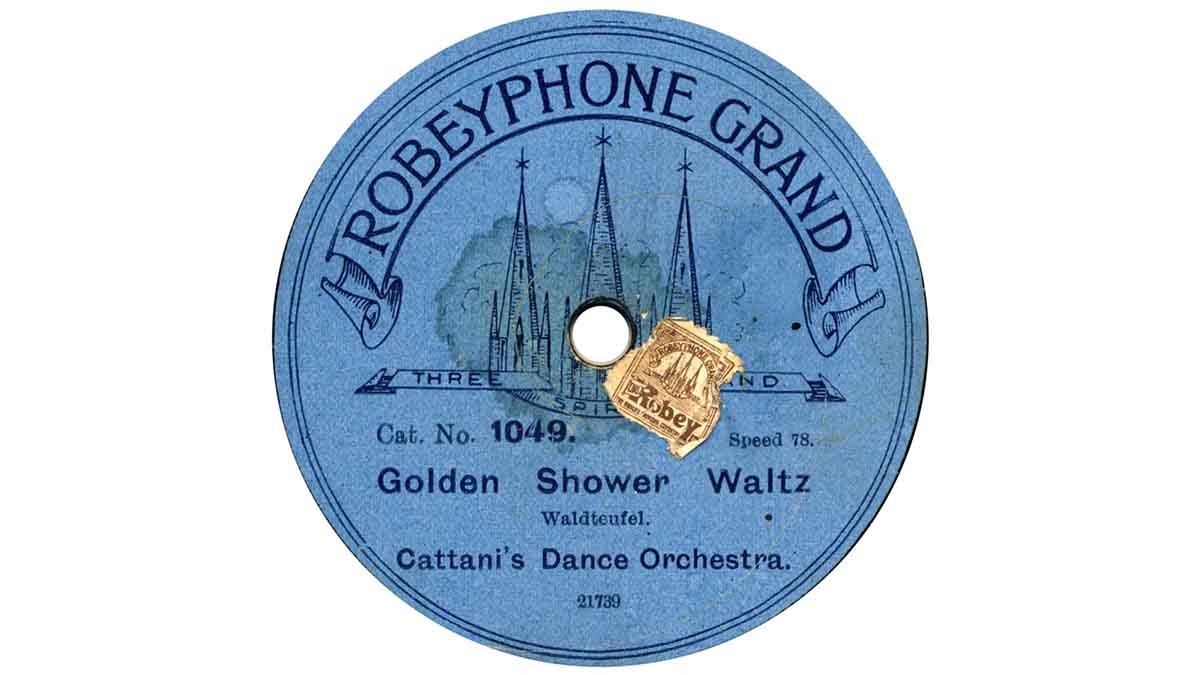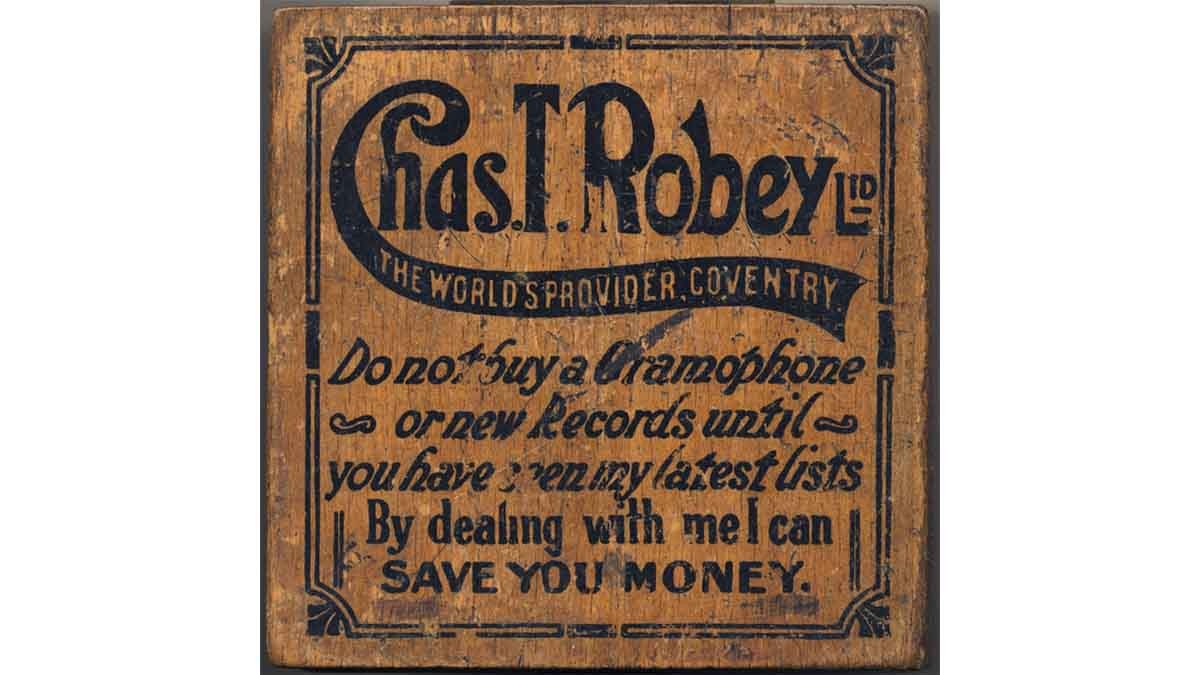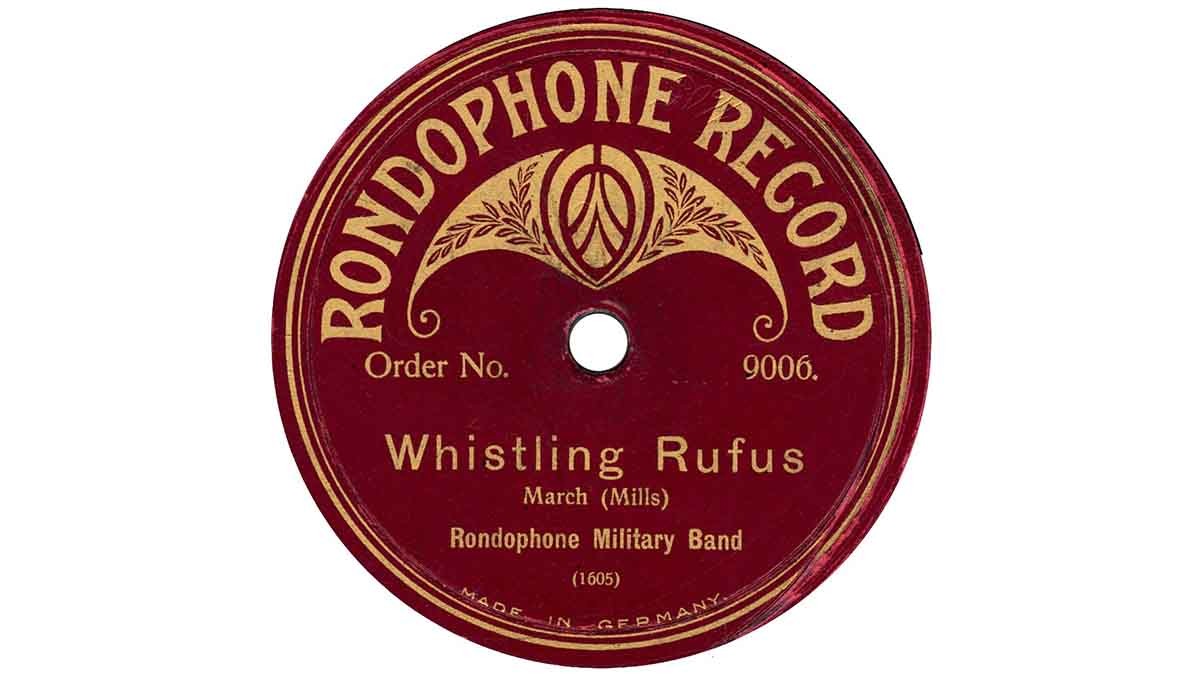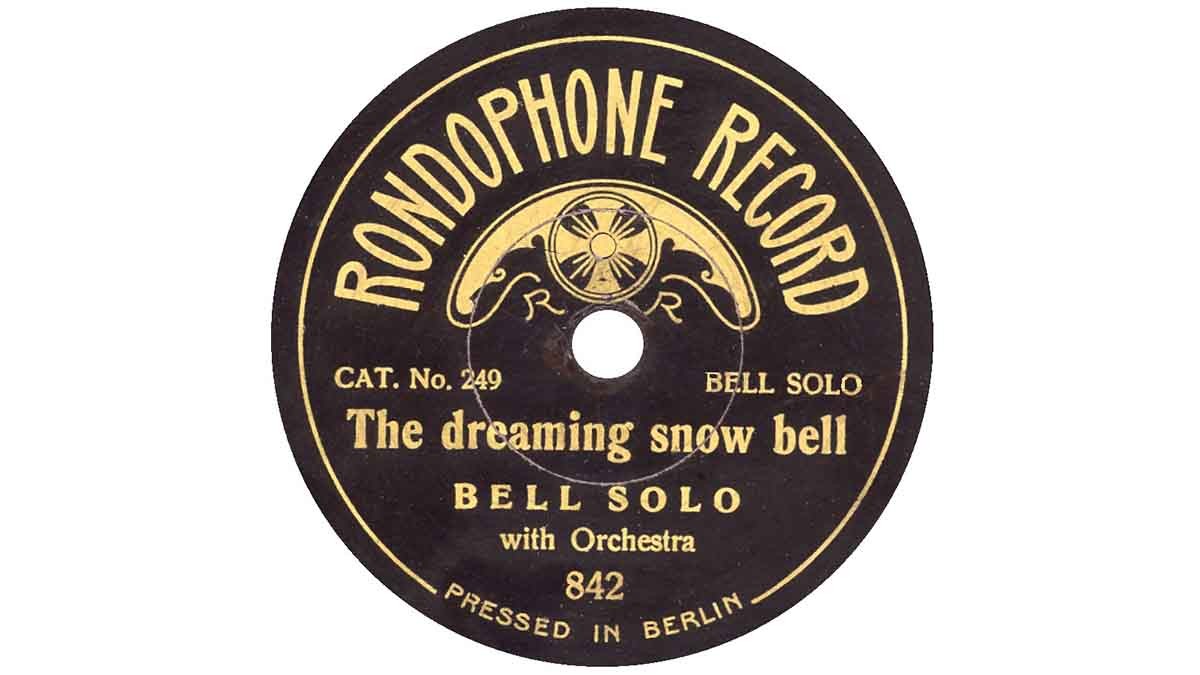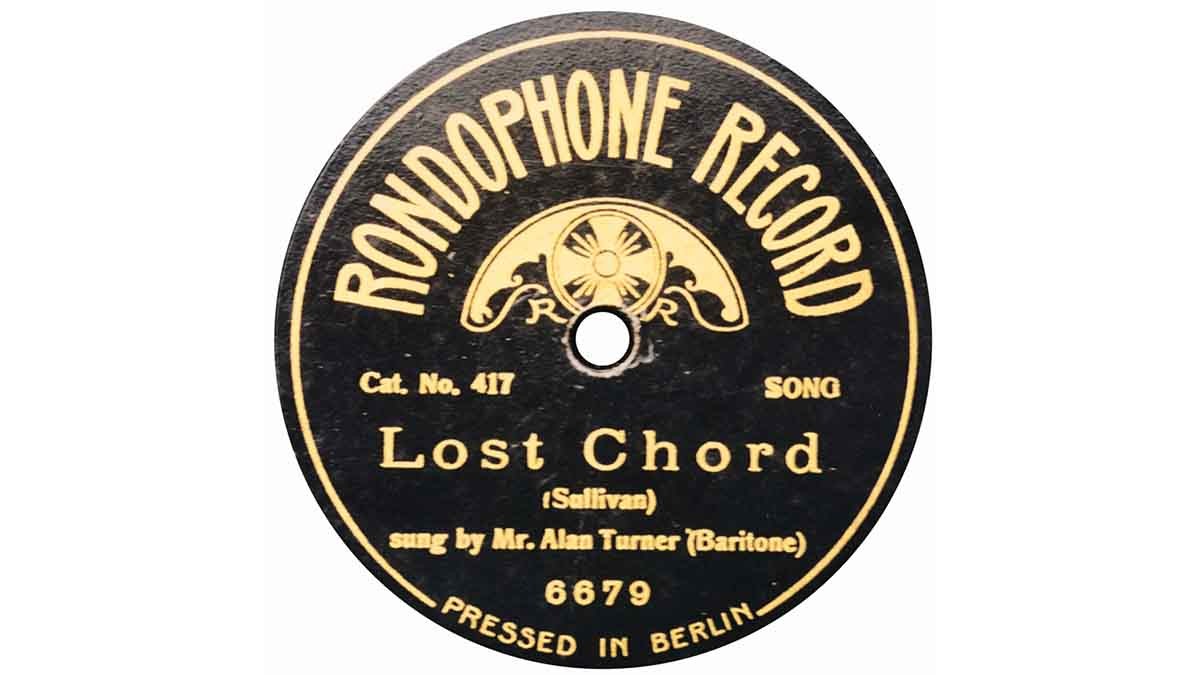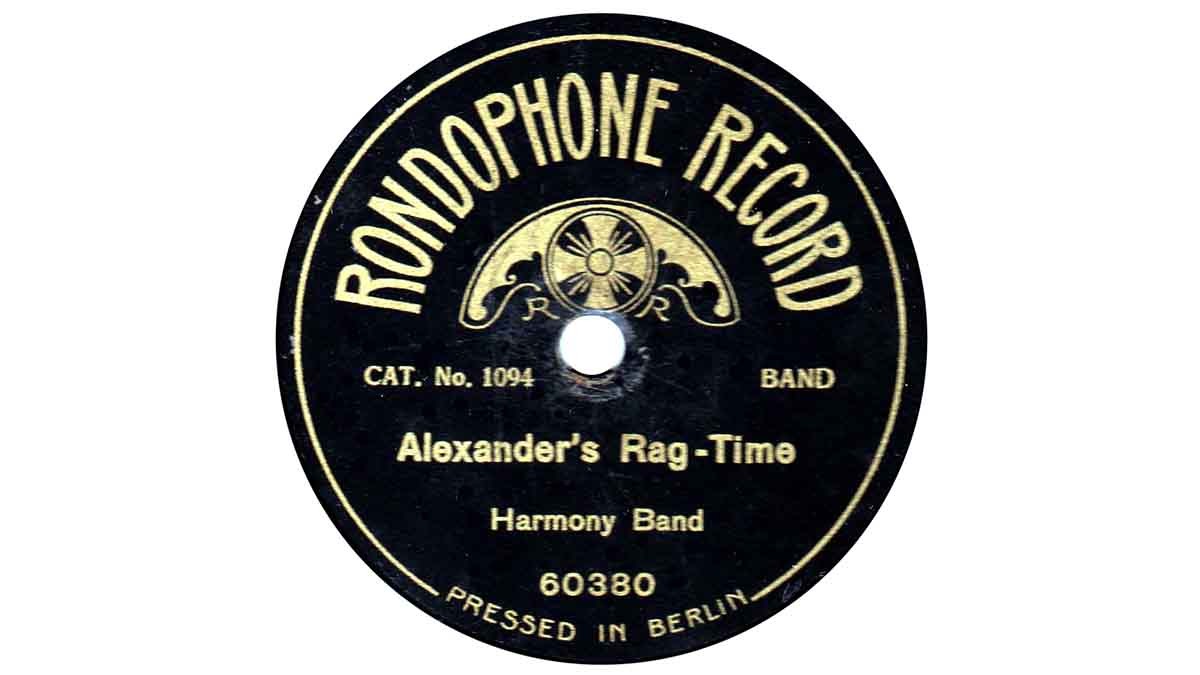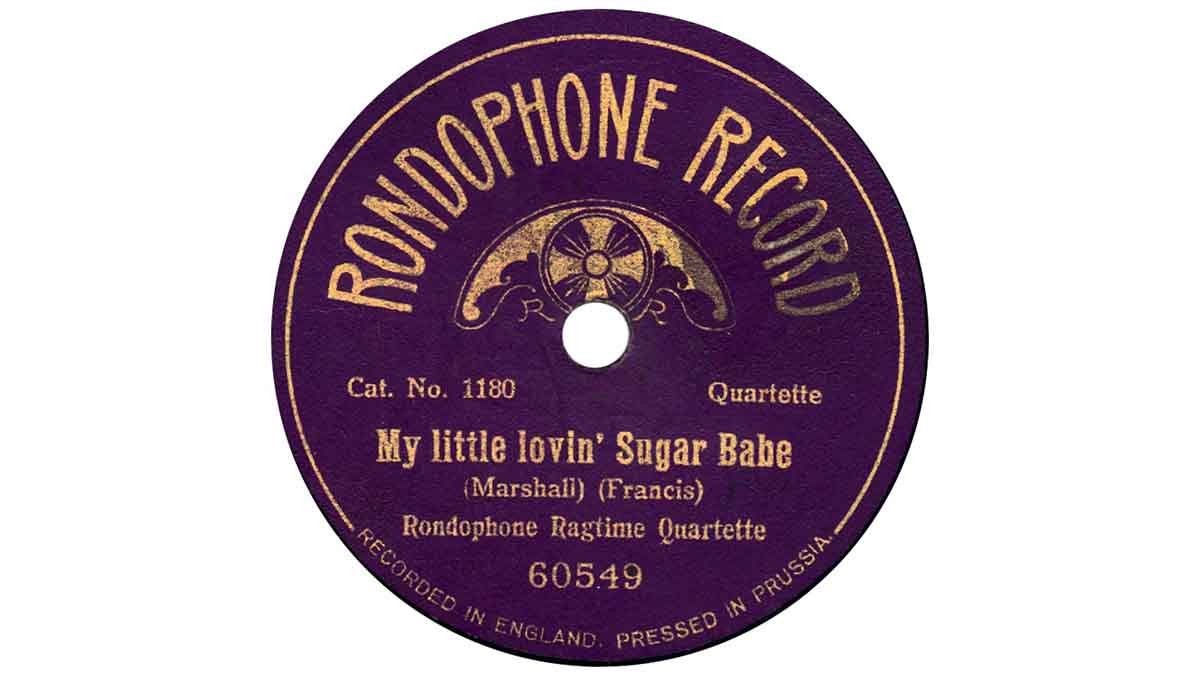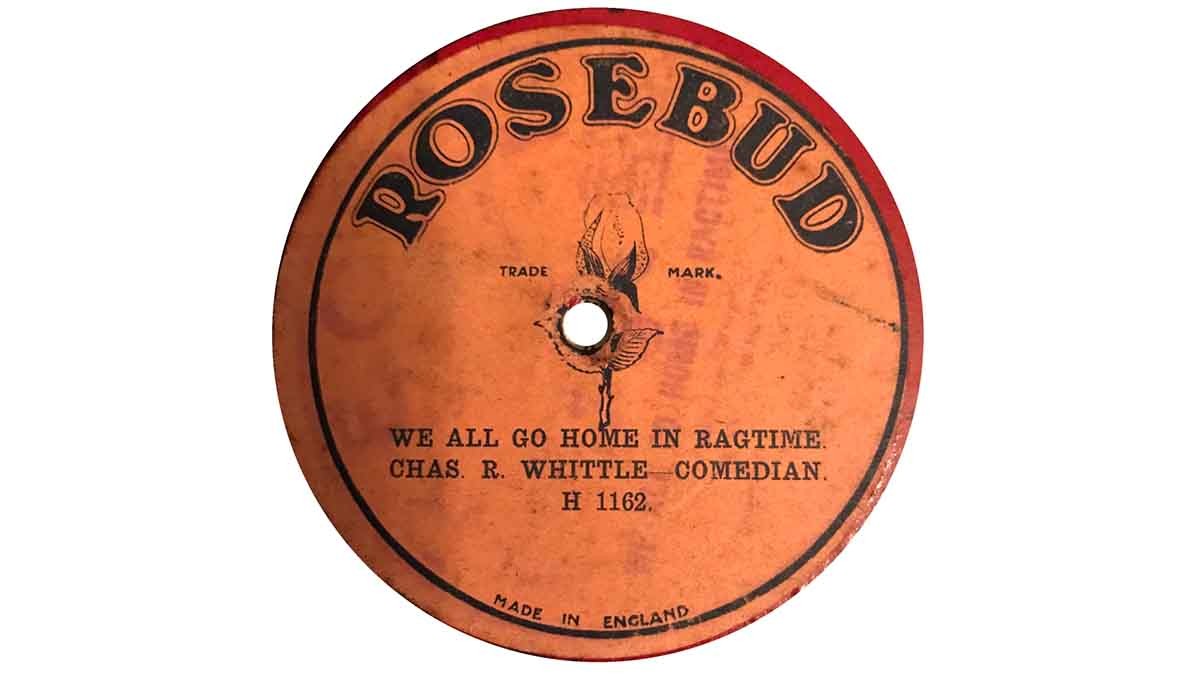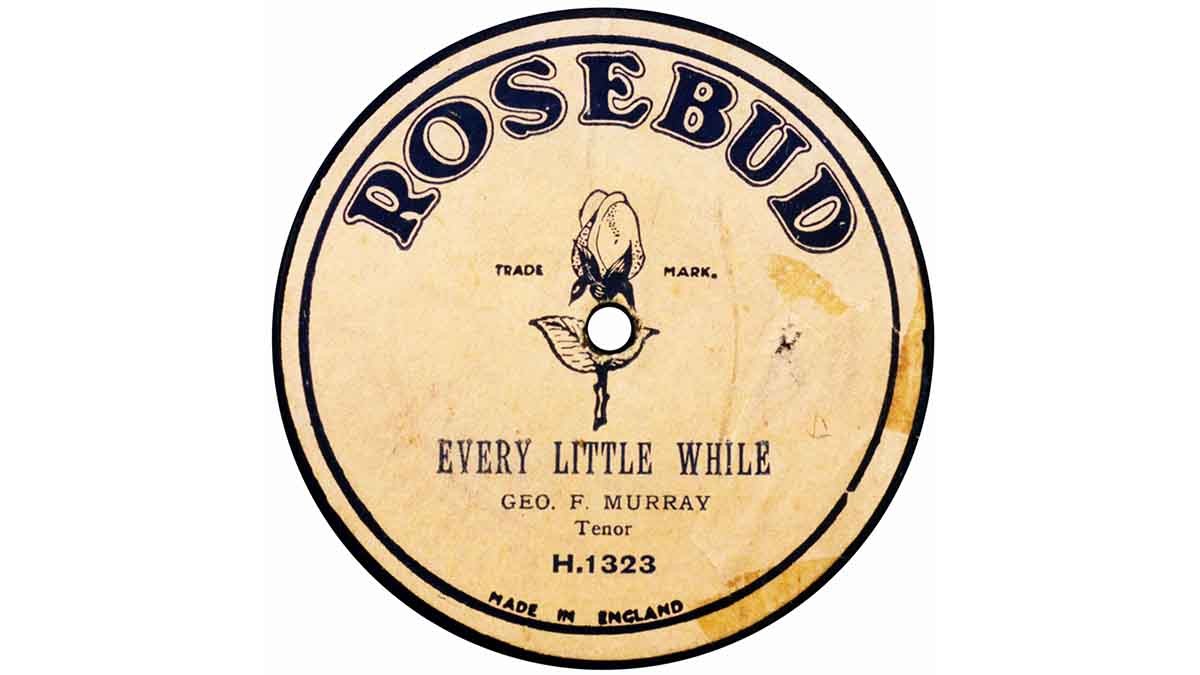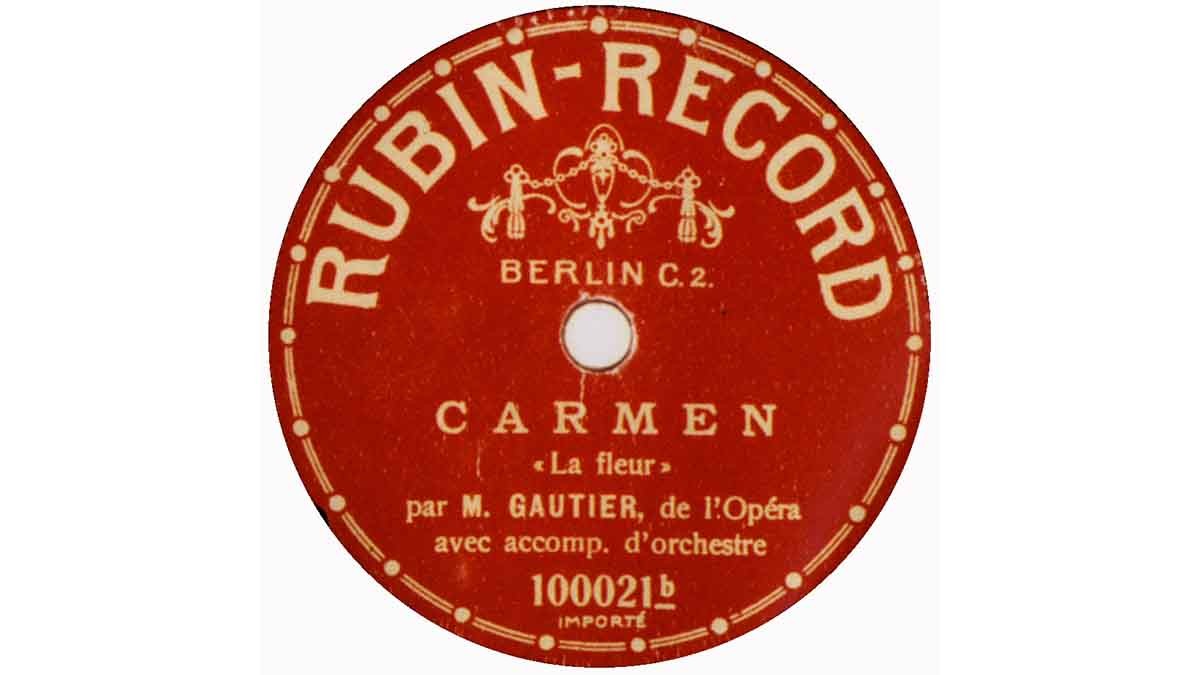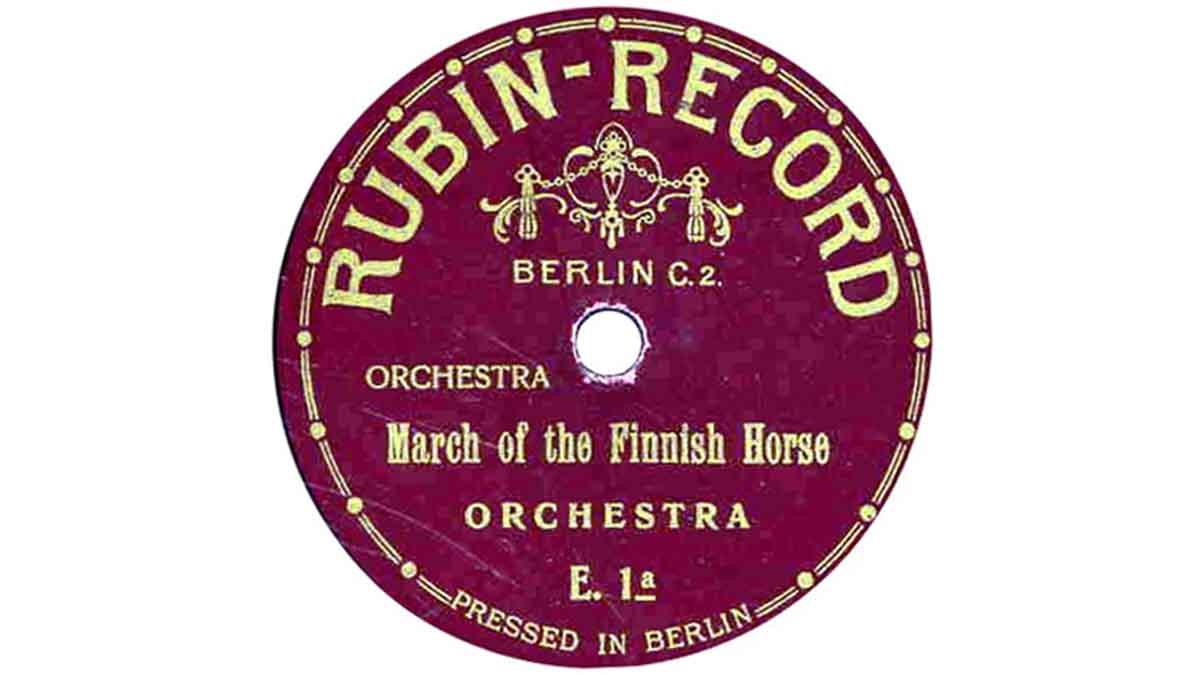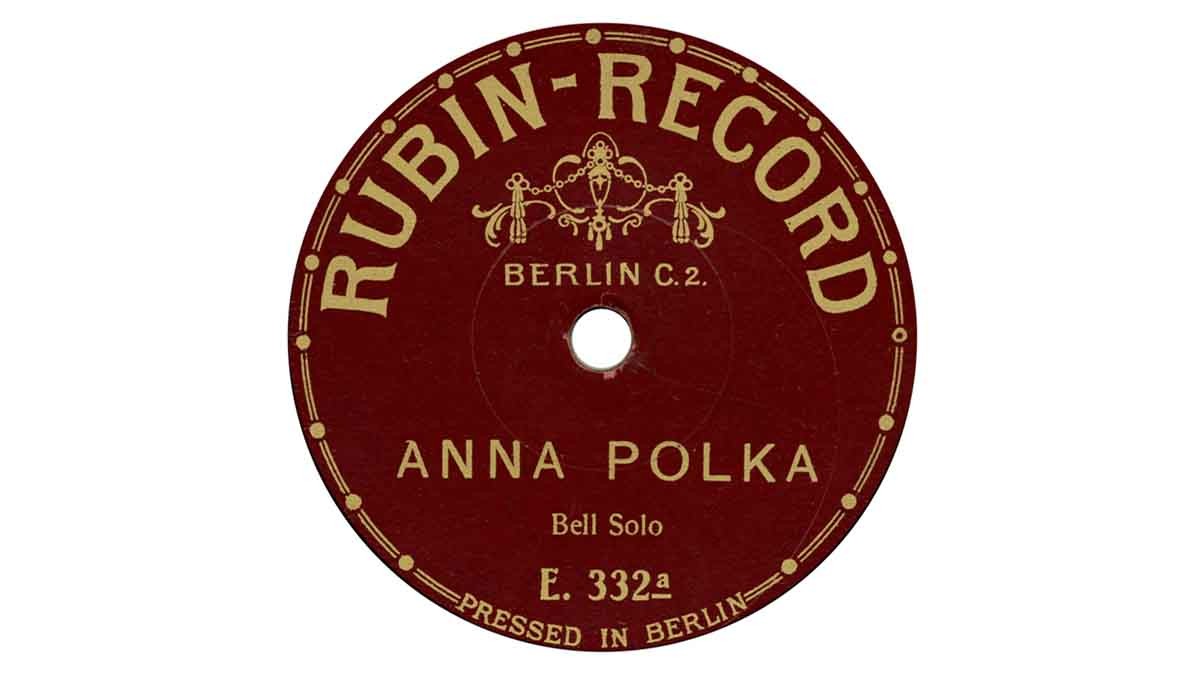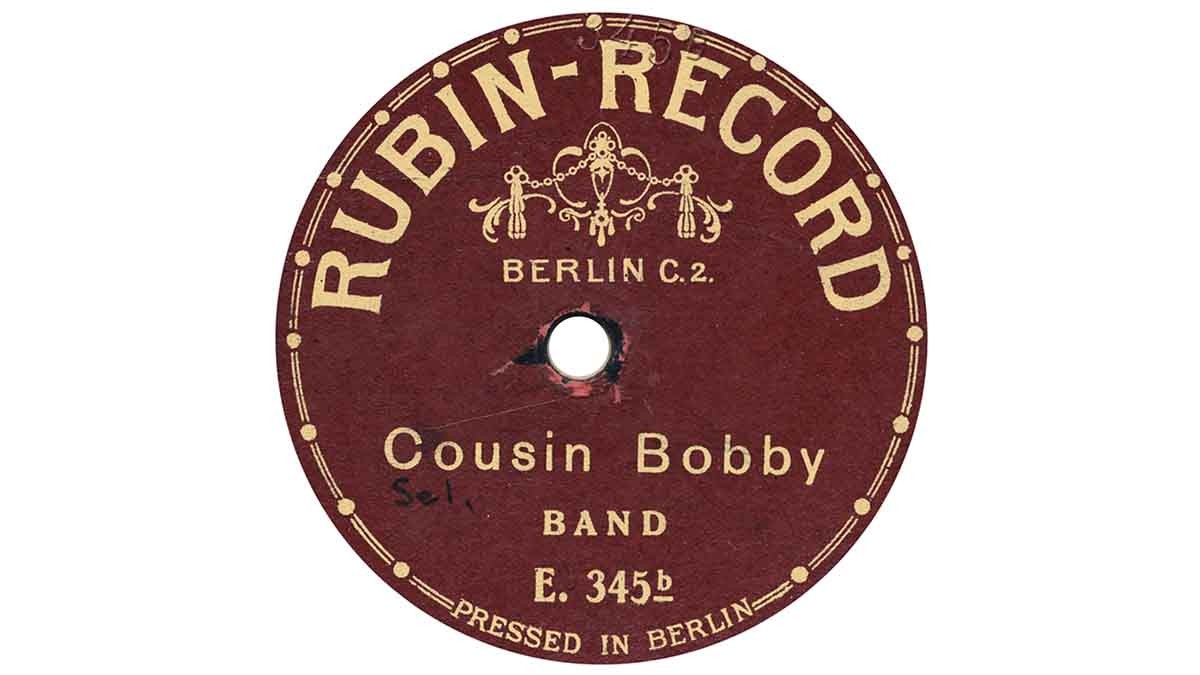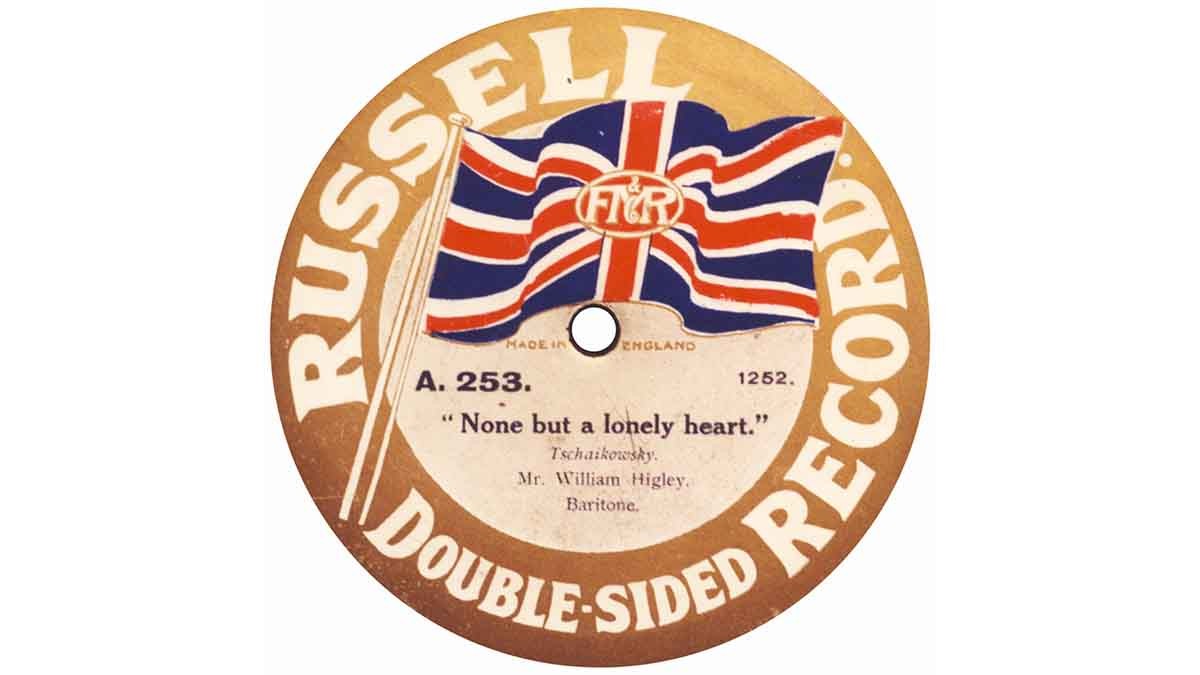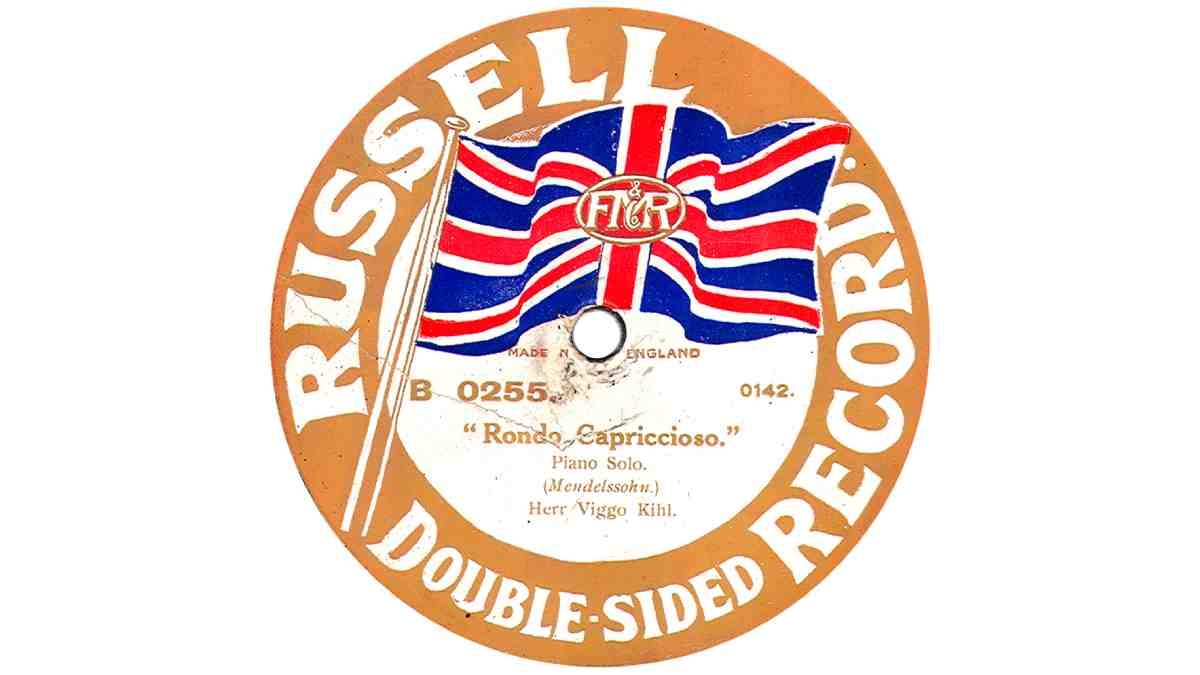
Early British record labels 1898-1926: R
Rach-o-phone | Raleigh | Regal | Regent | Regentone | Rembrandt | Rena | Restaurant Frascati | The Rex | Rexophone | Roberto | Robeyphone Grand | Rolf Winner Succes | Rondophone | Rosebud | Royal 1 | Royal 2 | Rubin | Russel
Rach-o-phone
See Frank Andrews, FTR 42, 2012. Frank tells us that the proprietor of these very elusive discs was Israel Rachovitch of Whitechapel in East London, which explains the Jewish symbol of the two tablets on the label, and which bear the initial letters of his name. He first advertised a ‘Rachophone Concert Record’ in November 1912, and continued to advertise in the Trade Press until April 1913. The discs were made in Germany by Kalliope, using masters that had hitherto belonged to Leonard A Blum (see Diploma, Stella, Victory) but over which Blum had lost control due to a dispute. ‘Mysterious Rag’ is on Kalliope 6188 credited to Jack & Nancy Charman, and the other side ‘A Day’s Fishing’, a comedy sketch, may be found on Kalliope 6186 by Jack Charman & Company. As to an ‘end-date’, that is uncertain – but it cannot be later than August 1914. So we have a scarce label that existed for well under two years.

Raleigh
See Frank Andrews, FTR 42, 1012. Frank tells us that there were only 2 Raleigh records, 999 & 1000. They date from 1909 and 1910. They were produced by ‘Columbia’ for ‘Rena’. The ‘A’ side of each was ‘A Cyclist’s Song’ by Harry Fay. David Mason, who kindly supplied the image of 999, tells us that the song is a re-setting of ‘Sally in our Alley’ – no prizes for guessing the fundamental rhyme-scheme! The reverse of 999 is a band selection from ‘Our Miss Gibbs’, a smash-hit show of 1909, while 1000 is backed with a band version of ‘The Merry Widow’ waltz. The records were issued to cycle dealers who also sold gramophones – a very common thing in those days, for the trade in both was highly seasonal; thus they went together under one roof very well. In addition, the maintenance and repair requirements of cycles and gramophones were quite similar.
Regal
All information relating to Regal may be found in the monumental book “Regal Records – 1914 to 1932”, Michael Smith & Frank Andrews, published in 2006. A further edition came out in December 2007, also with a credit to the late Arthur Badrock, published by the CLPGS. ISBN 0-900-883-99. Its 360 pages contain a complete listing of the label, preceded by a history of it. The work may be obtained from the bookshop of the CPLGS.
Suffice it to say that Regal was a cheaper label of Columbia, introduced in February 1914, with a large block of pre-existing recordings, and in a G-6000 series. Most of the early label types are illustrated above. Idiosyncratically, the three different sizes of record all have the same prefix. G-7000 was issued in September 1915 and G-8000 in September 1923. The label sold well and is still common today, though the sheer number of discs issued means that there are many rarities among them. The black label was used to distinguish a large block of accordion records of Scottish material by Peter and Daniel Wyper. The unusual 10.75″ sides in the G-5000 series are all Odéon masters of John McCormack, recorded before 1910. They came into the possession of Columbia through its taking over of the old Lindström works & its assets at the end of the Great War. They run from G-5000 to G-5006.
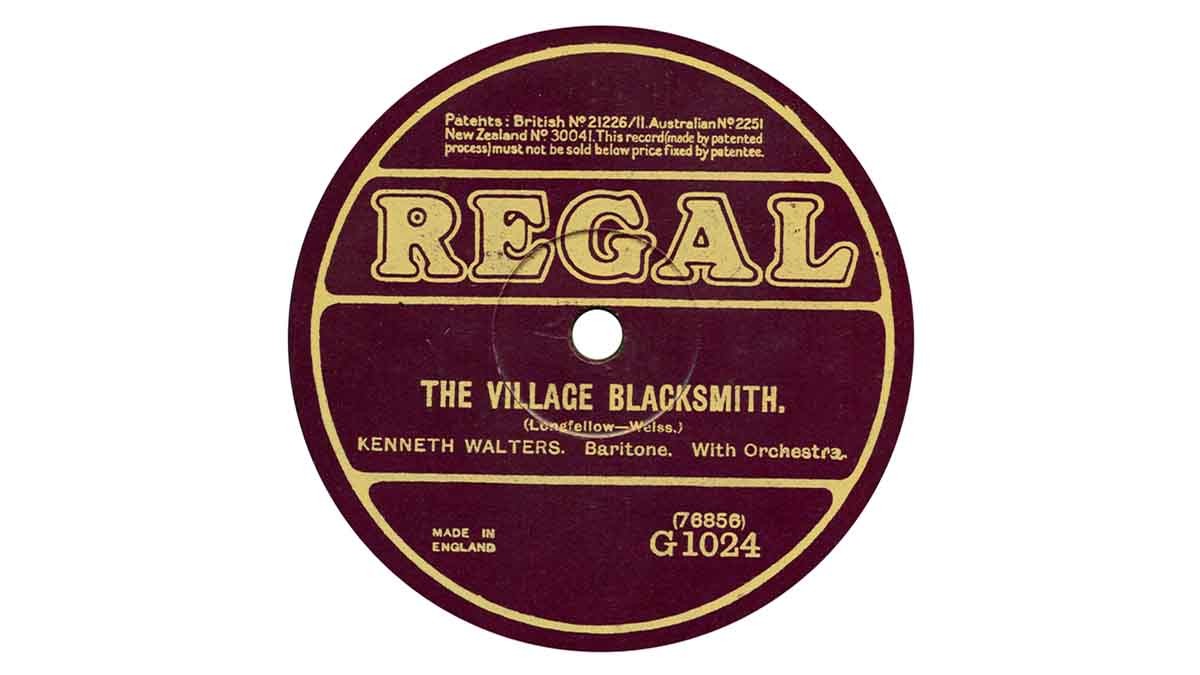
Regent
The Brighton Regent Orchestra played in the brand-new and luxurious Regent Cinema, which opened in July 1921. About a year later, they recorded for Regal, and the results were duly issued on that label. However, they were also custom-pressed for their own Regent label. They are well recorded & beautifully pressed by Columbia, of which Regal was, of course, a subsidiary. They are not as scarce as one might expect. The conductor is Basil Cameron (1884 – 1975), who had a notable international career.
Regentone
We know little about this very scarce label. The proprietor is unknown. However, three examples above were all pressed from Beka masters, and the second and third carry, embossed in the wax, the legend: ‘MADE IN ENGLAND’, which signifies a product of the Disc Record Company, of Stockport, and later north London. They possessed a large number of masters from various sources including Beka, and made client pressing from these. The label is perfunctory in the extreme, as you can see, bearing no artiste credit and no catalogue number. However, master numbers are present in the wax, which allow us to trace ‘Don’t Go Down The Mine, Dad’ to Beka 380, which was issued in January 1911, credited to James Hudson, baritone. The other side, perhaps inevitably, is ‘The Miner’s Dream of Home’, 41004, which appeared on Beka 369, same credit, in December 1910. ‘When the Mists Have Rolled Away’ is printed in dark blue ink on a large (3.5″) label. The master is 40662: Beka 245 by Harry Thornton, issued December 1909. Likewise, the ‘Chocolate Soldier Waltz’, master 41021, first saw light of day on Beka 366, issued in December 1910. It is by the Beka London Orchestra, under Julian Jones. This seemingly esoteric information was found in the invaluable CLPGS Reference Series Booklet No.11. This deceptively modest A5 booklet contains a detailed history of the Beka label by our distinguished discographers Frank Andrews and William Dean-Myatt, and comes with a CD-ROM which lists details of many thousands of Beka masters. This publication received an award of Merit from the prestigious Association of Recorded Sound Collections. You can have your own copy very easily: just go to www.clpgs.org.uk and click the link to ‘Reference Series’. What was the date range for Regentone? Probably not very long; the DRC already had some Beka masters, and got more in early 1914. On the other hand, the company had begun to fold by late 1914. As just a guess, 1910 to 1914, and possibly quite late in that range.
Rembrandt
See Frank Andrews, TMR 44, 2012. This extremely scarce label was marketed by the London firm Henry W Bush & Co.Ltd., probably around 1914. The first master seen is of U.S. origin, and was used on the Star label (Star – 1 on this website). Star was owned by Hawthorne & Sheble of Philadelphia, but they were driven out of business for infringing patents shared by Victor and Columbia. Star discs had already been imported as such to the U.K., but now there followed the metalwork from which they had been made, along with many others belonging to the American Record Co., which has been closed down in the same way. (‘Osman’ should of course be ‘Ossman’.) Thanks to information recently provided (2018) by Harry Haecker of New Zealand, it is now confirmed that these double-sided discs were pressed by the Disc Record Company, who had acquired those old U.S. masters – along with many other surplus U.K. masters, e.g. from Beka – as is the case with Harry’s disc. It has a two-sided selection from ‘The Dollar Princess’, recorded for Beka in London, March 1910. The files state that it’s by the Beka London Orchestra conducted by Julian Jones, so the ‘Irish Guards’ credit is spurious. The DRC must have acquired these Beka masters from Carl Lindström, most probably in early 1914. As the DRC ceased activity in late 1914/early 1915, this would give the latest date for their pressing.
Rena
See Frank Andrews, BRI. Frank also deals with Rena in the large book ‘Columbia 10″ Records 1904 – 1930’, published by the CLPGS in 1984. In short, they date only from 1908 to 1910, and were made by Columbia, from its own masters, for The Rena Manufacturing Co. The labels indicate a gradual ‘absorption’ of Rena into Columbia, as 1241 attests. As the book also lists all the 10″ Columbia-Rena and Columbia discs of ‘popular repertoire’, it is a very important work; but is currently, alas, out of print.
Restaurant Frascati
The above was a ‘freebie’ record, presented to clients of Frascati’s celebrated restaurant in London, at some period in 1927. One is not certain of how much you had to spend to be given such a disc, or for how long the free offer lasted. Suffice it to say, that the British Dance Band Enthusiast would – or should – be quite pleased if they managed to find a copy of it. It was manufactured by Crystalate, whose chief product of that time was Imperial records; however, it was not drawn from their standard catalogue, but specially recorded by Alan Selby and his Band, then currently resident at Frascati’s. The master prefix ‘CP’ – assumed to be Commercial Pressing – is in a special series. How many copies were handed out buckshee? Your guess is as good mine. Fifty? A hundred? A couple of hundred? Who knows? If you find one in superb condition, and don’t want it for yourself, pop it on eBay. You may be pleasantly surprised.
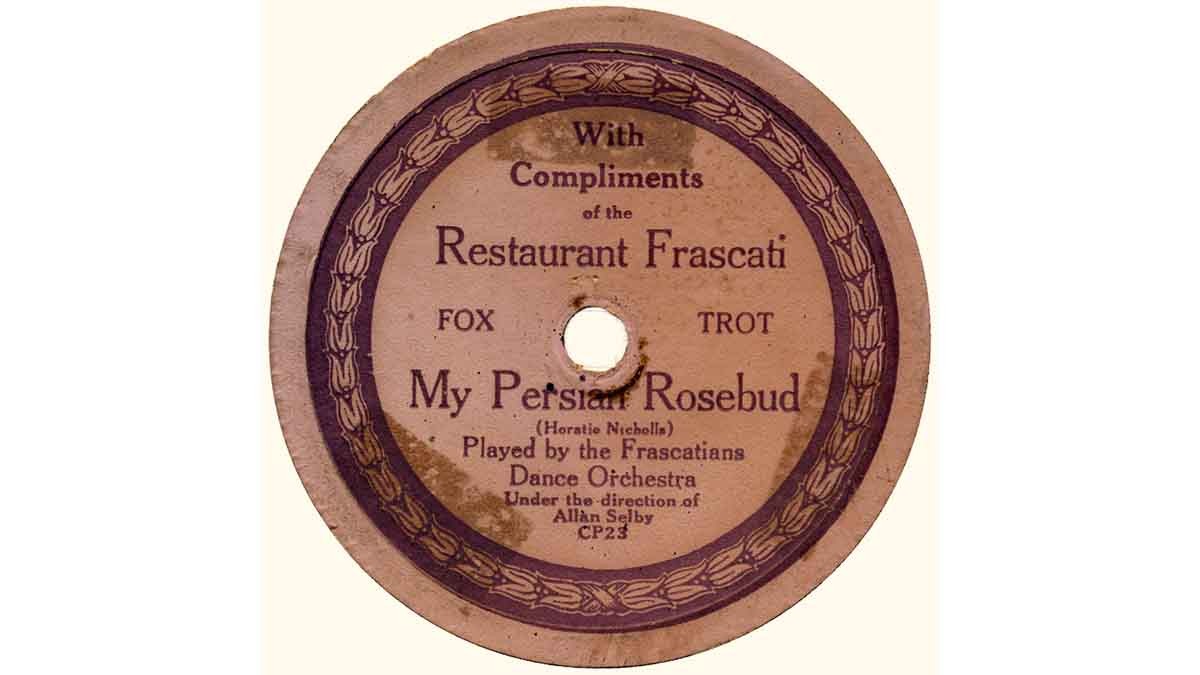
The Rex
See Frank Andrews, BRI. This exceptionally scarce label probably dates from circa 1910. A monochrome label image appeared in HD 203, which, as Frank Andrews pointed out, resembled the Nicole label, but the repertoire was too late to have been recorded by Nicole. However, The Disc Record Co. owned the Nicole masters and had pressed records from them since 1907, and continued to do so until its demise in early 1915. Some of these (e.g. Empire – 1) also had labels which resembled the Nicole. The above was written before we had seen an actual Rex record, both sides of which are shown above. It is definitely a DRC product, carrying their characteristic ‘MADE IN ENGLAND’ in the wax. The curious ‘Wigga Waggo’ is from a Beka master. The DRC had acquired some of these, this being 40613, which also appeared on John Bull as ‘Wigger Wagger’. It was originally Beka 234, issued November 1909 with its full & correct title: ‘With My Little Wigger Wagger In My Hand’, sung by Bert Alvey. Most confusing! The proprietor of The Rex Record is unknown.
Rexophone
Thanks to John Culley, Ian McPherson, Malcolm Johnson and Dr. Rainer Lotz for these scans of rare Australian discs. Earlier Rexophones were the product of the German concern Homophon GmbH. They were mostly recorded in London, though as you see, some French material appeared. Homophon pressed them in Berlin (Prussia). Whether the discs came back here before they were finally sent to Australia is not known; the British copyright stamps might have been sent to Germany? The catalogue series looks like it began at 5000, so over 1,000 different Rexophones may have once existed. ‘Silver Bell’ has a mother plating date of 26th July 1911 and a stamper plating date of 25th February 1913. ‘On The Road To Zag-A-Zig’ has 8th January and 12th February respectively, both in 1912. Therefore it is reasonable to allocate a provisional range of 1912 – 1914 to these Rexophones. Three different label designs were employed; re-pressings took the new design, so they are intermingled. When the Great War broke out in August 1914, German imports naturally ceased, and production was take over by Edison Bell. For example, 5784 is a clone of Winner 2803, which was issued in May 1915. Alas, soon Edison Bell became too busy to make client pressings, so that may have led to the démise of Rexophone. Thanks to Dr. Rainer Lotz for his extra information on this label.
Roberto
See E78PB. Excessively scarce! A crude label, saying ‘Roberto Record’ and nothing else, stuck over most of the label (but not the title and artiste credit) of a 1911 Columbia-Rena (or Columbia). Don Taylor is surely correct when he suggests that these must be surplus discs jobbed off by Columbia, probably c. 1914-1915 when that company introduced their Regal label. But who ‘Roberto’ might have been, is of course, unknown.
Robeyphone Grand
See Frank Andrews, FTR 47, 2013. The proprietor was the Coventry retailer Chas. T Robey Ltd., ‘The World’s Provider’ as announced on the lid of the wooden needle box shown here, as well as the Robey stamp on 1049 – which is rather an oddity. The discs are uncommon, and are drawn from Odeon/Jumbo masters, including some made in Berlin. Tunes of 1913 are known, besides earlier standard fare. They were manufactured at the Lindström works in Hertford; and if so, may have continued after the outbreak of war up until the Lindström business was closed down & taken over by the government in 1916. Frank gives much extra information in his essay.
Rolf Winner Succes
A label produced in about 1919-20 by ‘Edison Bell’ for a Swedish concern belonging to Ernst Rolf. It would appear that initially the recordings were made in London, which must have necessitated much travelling. You may read – and hear – more on the YouTube channel belonging to 78rpmblog.

Rondophone
See Frank Andrews, FTR 47, 2013. A scarce Australian label, recorded in London, and manufactured in Germany by Homophon GmbH. The recording of ‘Seagull’ was made in 1910, but bears a ‘stamper plating date’ of 4th September 1912, therefore giving us a ‘not before’ date for this disc, if not the marque as well. The first disc, kindly sent with other scarce examples by Dr. Rainer Lotz, is placed first, as it has only a face number, not a catalogue number. Frank tells us that the Rondophone catalogue numbers were the same as the British Homophone ones. It is not known whether all British Homophones also appeared as Rondophones. If they did, nearly 1,200 Rondophone discs must have been produced for the Australian market. Curiously, none we have seen bear copyright royalty stamps. This might indicate they were produced before 1912, when the Copyright act came into force. The label cannot have continued after August 1914, owing to the Great War. The proprietor is unknown. See the Homophon date codes.
Rosebud
See E78PB. Don Taylor tells us that Columbia disposed of surplus stock of Regal and Columbia 1914-18 period discs by jobbing them off to a merchant, either in Australia, or one in the U.K. who then sold them on to Australia. However, exactly when this occurred is not known to us. The Rosebud labels were stuck on at some point. The series began at H-1000. 12″ discs were also converted into Rosebuds. Light brown, & also cream labels are to be found. The Regal label can be seen beneath H-1162; it’s Regal G-6622, part of the huge first issue (several hundred!) of Regals in February 1914. However, these had already been on Columbia; this one was on Columbia 2218, issued in October 1913. The Regal itself was deleted in July 1916.
Royal 1
Possibly as early as 1906, a label called ‘Royal Record’ was produced for an unknown proprietor. They were either pressed in London at the Nicole works, or in Stockport, Cheshire by the Disc Record Co; if the latter, this would be perhaps a couple of years later. In either event, pre-existing Nicole masters were used, the D.R.C. having bought in the equipment & metalwork of Nicole when it was wound up. They are extremely scarce, but are known to have been double sided; some had red labels with gold printing, while others had black & silver. They carried the device of two crossed herald’s straight trumpets.
Royal 2
The above is a Dacapo record, albeit a German one, over-stuck with ‘Royal Record’ half label. Dacapo appeared in Germany in 1907, and in this country in 1910. Also, an example has been reported over-stuck on a Diploma Record, which at least indicates that Royal is also a British affair. Diplomas were first made here by ‘Edison Bell’, and later in Germany, first by Kalliope and then by another, unknown maker in Prussia, & finally in London. The proprietor of Diploma was the merchant Joseph L Blum, who also had the Famous, Stella, & Victory labels – probably so that he could supply several dealers in one town, without causing undesired competition between them? Blum ceased trading in early 1915, so remaining stocks of Diplomas may have been bought up cheaply, and ‘re-badged’ as Royal? Equally, the Diplomas might have come from bankrupt stock of any retailer.
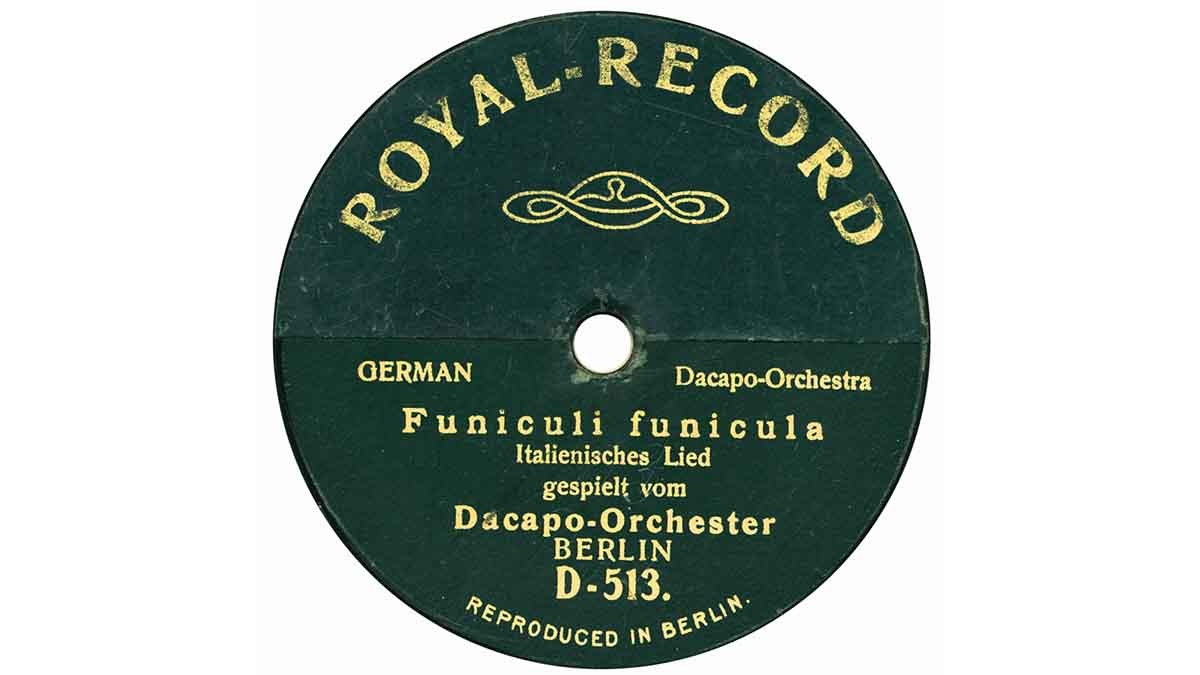
Rubin
Another scarce label, also produced by Homophon, as a cheaper line, probably for the last ‘price war season’ of 1913-1914. Year dates between 1907 and 1911 are found in the wax, so the latest date will tend to indicate their period of existence, shadowy as it was. Whoever imported & distributed them in this country is unknown. In any case, that arrangement would have terminated in August 1914. However, Homophon also made Rubin records for sale in other countries, as the above French example attests. That being the case, the ‘E’ prefix of the British Rubins may stand for ‘England’. See the Homophon date codes.
Russel
See Frank Andrews, BRI. An exceedingly scarce double-sided label, Frank tells us that it only existed between June and September 1908. It was a product of F M Russell & Co. Ltd., The Junction Works, Willesden, London N.W.10. Only eighteen 10″ discs and fifteen 12″ discs were issued in all. They were all original recordings. The exuberant label is very large at 4″ (10 cm).
